
Abandoned & Little-Known Airfields:
California: Oakland area
© 2002, © 2016 by Paul Freeman. Revised 11/29/16.
This site covers airfields in all 50 states: Click here for the site's main menu.
____________________________________________________
Please consider a financial contribution to support the continued growth & operation of this site.
Alameda Airport / Benton Field / Alameda NAS (revised 11/5/16) - Benicia Airport / Benicia Air Harbor (revised 4/13/16) - Byron Airpark (revised 12/18/13)
(Original) Concord Airport (revised 11/29/16) - Concord NWS Airfield (revised 1/30/16) - Discovery Bay Airport (revised 6/6/16)
Knights Airport / Stan's Airpark (revised 6/6/16) - Mare Island Naval Shipyard Airfield (revised 2/21/15) - Martinez Airport (revised 2/26/16)
San Francisco Bay Airdrome (revised 10/6/16) - Sherman Field (revised 1/25/16) - Vallejo Airport / Mini Airport / Vallejo Sky Harbor (revised 8/18/16)
____________________________________________________
Mare Island Naval Shipyard Airfield, Vallejo, CA
38.089, -122.272 (Northeast of Oakland, CA)

An undated photo of a biplane (type undetermined) from the USS Langley at Mare Island (courtesy of Dann Shively).
The Mare Island Naval Shipyard was established in 1853.
Dann Shively reported (sourcing information from "Side-wheelers to Nuclear Power" by Sue Lemmon & E.D. Wichels),
“After World War I a supply ship, the USS Jupiter, was sent to Mare Island for retrofit
and became the Navy's first aircraft carrier, renamed the USS Langley.
It served the fleet from 1922-36 helping to develop carrier aviation.
From 1922-25, Mare Island was the site of an air station, or what local newspapers referred to as such.
It was unpaved & unlighted; any air traffic was a rare event; not much of an air station.
Photographers stayed away from it so carefully that no decent pictures of it exists.”

An undated photo of a Curtiss JN-4 Jenny biplane at Mare Island (courtesy of Dann Shively).
According to Dann Shively, “Some of the very early aircraft carriers that came to Mare Island, such as the USS Langley & the USS Aroostook,
had no place to 'park' their small planes while the ship was undergoing overhauls so they used the airstrip.”

An undated photo of a Curtiss JN-4 Jenny taking off in front of the Mare Island Marine Barracks (courtesy of Dann Shively).
According to Dann Shively, “It was hoped the small field could be expanded, but such hope faded in 1937, when Alameda was selected as the site for a naval base.”
There is no indication of any further aviation use of the Mare Island airfield.
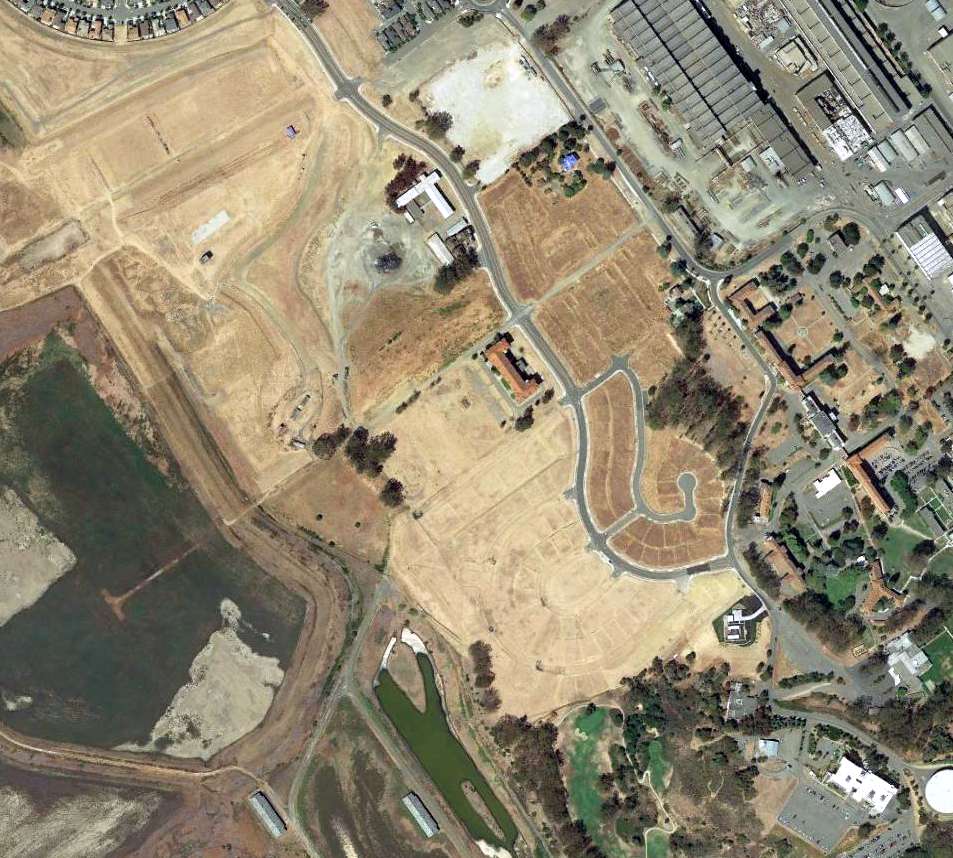
A 2014 aerial view of the general location of the Mare Island Airfield, centered on the former Marine Barracks located at 13th Street & Flagship Drive.
Thanks to Dann Shively for pointing out this airfield.
____________________________________________________
Benicia Airport / Benicia Air Harbor, Benicia, CA
38.075, -122.19 (Northeast of Oakland, CA)

Benicia Airport, as depicted on the 1950 USGS topo map (courtesy of Dann Shively).
Photo of the airport has not been located.
This small general aviation airport along the north bank of the Sacramento River was evidently established at some point between 1946-50,
as it was not yet depicted on the 1946 Sectional Chart (courtesy of Dann Shively).
The earliest depiction which has been located of Benicia Airport
was on the 1950 USGS topo map (courtesy of Dann Shively).
It depicted Benicia Airport as having 2 runways on a narrow spit of land next to the wetlands, with one small building along the east side.

The only aeronautical chart depiction which has been located of Benicia Airport was on the 1954 Sectional Chart (courtesy of Dann Shively).
It depicted Benicia Airport as having a mere 1,900' runway.

The 1955 CA Highways map (courtesy of Kevin Walsh) labeled the field as “Benicia Air Harbor”.
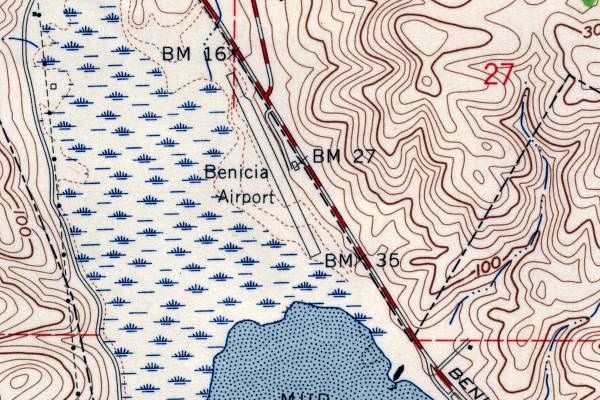
The last depiction which has been located of Benicia Airport was on the 1959 USGS topo map (courtesy of Dann Shively).
Benicia Airport had lost its crosswind runway at some point between 1950-59.
Benicia Airport was depicted in an unchanged fashion on the 1965 USGS topo map.
Benicia Airport was evidently closed (for reasons unknown) at some point between 1954-65,
as it was no longer depicted on the June 1965 Sacramento Sectional Chart (courtesy of Ron Kunse)
nor on the 1969 USGS topo map.
No trace of Benicia Airport was recognizable on a 5/22/72 USGS aerial photo.
At some point after the closure of Benicia Airport, the site was reused as a park named Benicia State Recreation Area.

An undated aerial photo from a park map (courtesy of Dann Shively) depicted the northern portion of an abandoned runway at the site of Benicia Airport.

A 2006 photo by Dann Shively looking south at the Benicia State Recreation Area, showing no trace remaining of Benicia Airport.
The site of Benicia Airport is located south of the intersection of Route 780 & Rose Drive.
Thanks to Dann Shively for pointing out this airfield.
____________________________________________________
Martinez Airport, Martinez, CA
38.023, -122.133 (Northeast of Oakland, CA)

A 1937 photo of a hangar marked “Martinez Air Port”, with the radio mast visible in the background (courtesy of Dann Shively).
According to the book “Images of America: Martinez” (courtesy of Kevin Walsh),
“A deputy sheriff built the first hangar at Martinez Airport in 1933.”
The earliest depiction which has been located of Martinez Airport
was a 1937 photo of a hangar marked “Martinez Air Port”, with the radio mast visible in the background (courtesy of Dann Shively).

A 1939 aerial view looking southeast showed Martinez Airport to have a single east/west runway with a few small buildings on the west side.
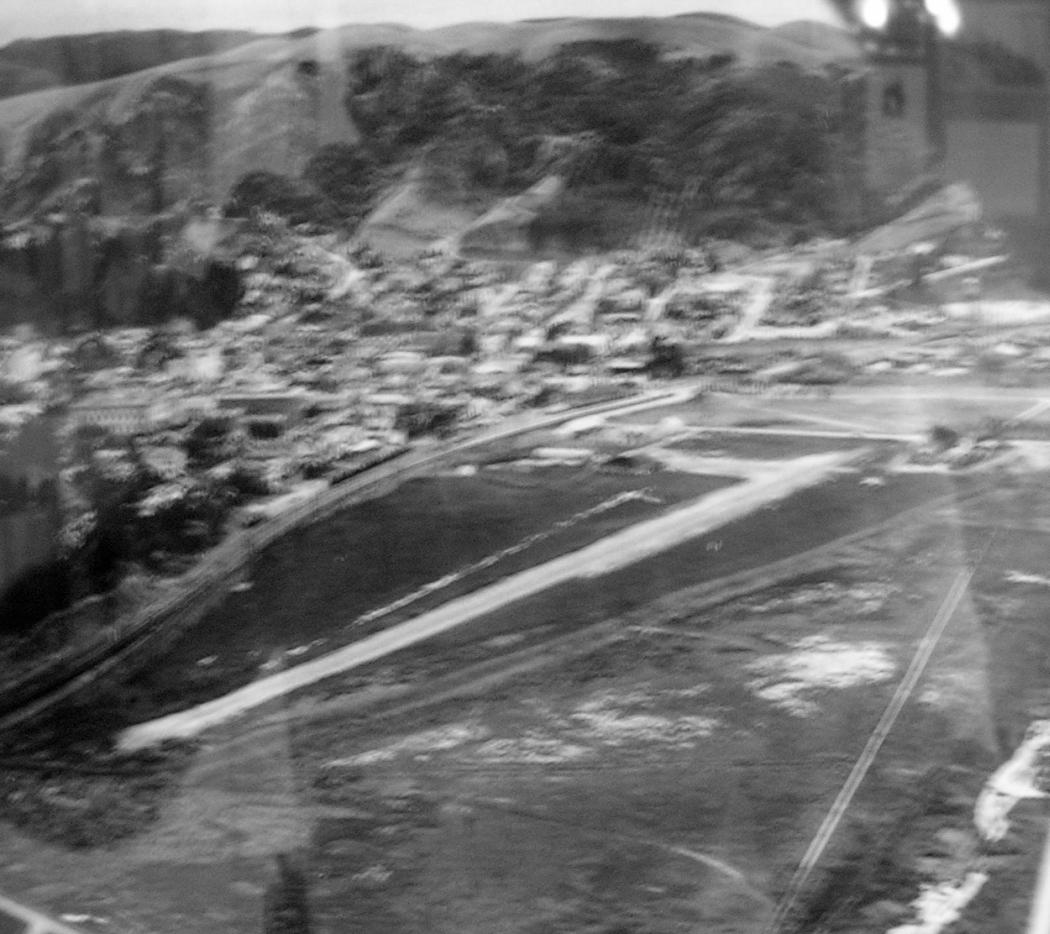
An undated aerial view looking southwest (courtesy of Dann Shively)
showed Martinez Airport to have a single east/west runway with a few small buildings on the west side.

The 1940 USGS topo map (courtesy of Dann Shively) depicted Martinez Airport with the propeller symbol along the coast.
Martinez Airport may have been closed at some point between 1940-45 (like many other civilian airports near the coasts during WW2),
as it was not listed among active airfields in the 1945 AAF Airfield Directory (courtesy of Scott Murdock).

Martinez Airport evidently reopened at some point between 1945-46,
as the 1946 Sectional Chart (courtesy of Dann Shively) depicted it as a commercial/municipal airport.
Al Blachman reported of Martinez Airport, “Norm Spitzer worked as a flight instructor there after WW II.”
William Ludwig recalled, “The runway was a dirt strip running east & west located on the north side of downtown of Martinez next to the bay.
It had a single barn-like hangar on it & that was it. A friend I knew had an Ercoupe out there for awhile,
and a kid wanted one day to take it for a joy ride & crashed it. Wes Lewis was the owner of the plane.”
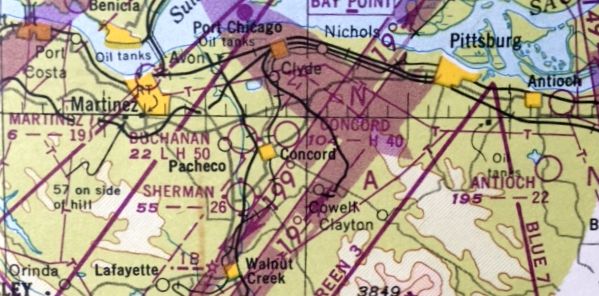
The 1949 Sacramento Sectional Chart (courtesy of Kevin Walsh)
depicted Martinez Field as having a 1,900' unpaved runway.
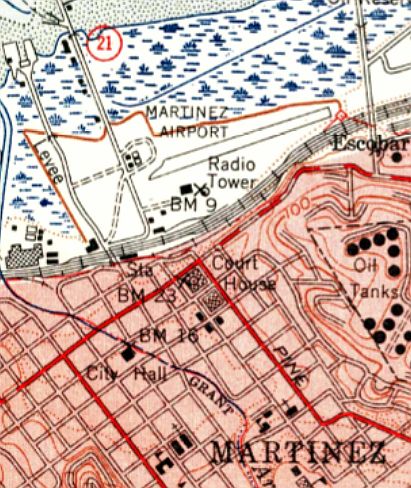
The 1950 USGS topo map depicted Martinez Airport as having a single northeast/southwest runway,
with a few small buildings on the west & southwest sides, and a radio tower on the south side.
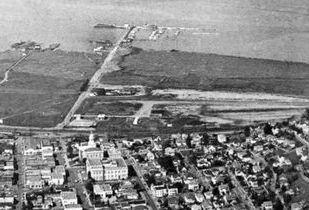
The last photo which has been located of Martinez Airport was a 1950 aerial view looking north (courtesy of Kevin Walsh).
It depicted Martinez Airport as having an east/west runway with a hangar at the southwest corner.

A 1953 street map simply labeled Martinez as “Municipal Airport” (courtesy of Kevin Walsh).

The last depiction which has been located of Martinez Airport was on the 1954 Sectional Chart (courtesy of Dann Shively).
It depicted Martinez Airport as having a mere 1,600' runway.
Martinez Airport was evidently closed (for reasons unknown) at some point between 1954-58,
as a 1958 USGS aerial photo depicted the site had been scraped completely clean,
with not a trace remaining of the little airport.

A 2006 photo by Dann Shively looking east at Waterfront Park, not showing any trace of Martinez Airport.

A 4/16/13 aerial view showed no trace remaining of Martinez Airport.
As of 2014, street maps labeled the site of Martinez Airport as Martinez Waterfront Park.
The site of Martinez Airport is located northeast of the intersection of Joe DiMaggio Drive & North Court Street.
Thanks to Kenneth Wetherall for pointing out this airfield.
____________________________________________________
Byron Airpark (4Q5), Byron, CA
37.835, -121.636 (East of Oakland, CA)

The 1973 San Francisco Sectional Chart (courtesy of Jonathan Westerling)
depicted Byron Airpark as a private airfield having a 2,100' unpaved runway.
No airfield was yet depicted at this location on a 1938 aerial photos.
According to Rich Harrison, “The old Byron Airport... was built sometime during WW2 as an auxiliary training field
(possibly to support Concord Field training) and to support the Byron Hot Springs, which is adjacent to the field.
The Byron Hot Springs was a turn-of-the-century luxury resort that was used during WW2 as an interrogation facility for German and Japanese officers.
(I have heard that there was an airfield on the property some time prior to WW2 & was used by the Hot Springs.
The airfield was closed around the end of WW2.”
The Byron Airpark was not listed among active airfields in the 1945 AAF Airfield Directory (courtesy of Scott Murdock).
No airfield was depicted at this location on 1949 & 1959 aerial photos.
According to Jonathan Westerling, the December 2000 Contra Costa County Airport Land Use Compatibility Plan
described the Byron Airpark as “a small, privately-owned, public-use airport which had occupied the current property... since the 1950s.”
The earliest photo which has been located of the Byron Airpark was a 1966 aerial view.
It depicted Byron as having 3 unpaved runways.
The Byron Airport was not yet depicted on the 1968 USGS topo map.
The earliest aeronautical chart depiction which has been located of the Byron Airpark
was on the 1973 San Francisco Sectional Chart (courtesy of Jonathan Westerling).
It depicted Byron as a private airfield having a 2,100' unpaved runway.

The earliest photo which has been located of the Byron Airpark was a 4/11/74 USGS aerial view.
It depicted Byron as having 3 unpaved runways.
The 1976 AOPA Airports USA Directory (according to Jonathan Westerling) described Byron Airpark
as having 3 dirt runways, all 2,100': Runways 9/29, 4/22, and 14/32.
According to Rich Harrison, “I was a member of the Concord chapter of the EAA (393) in the mid 1970s to late 1980s.
One of the members was Bud. He & a couple of partners purchased the former airfield some time in the late 1970s.
They asphalted 2 of the 3 original runways & opened it up.
I flew out there in my Grumman Yankee many times for EAA activities, and to just stop in to say hi. Bud built a house adjacent to the airport.
They leased space for people to park their planes & put in Port-a-Ports.”
The 1979 AOPA Airports USA Directory (according to Jonathan Westerling) described Byron (4Q5) as a private airfield.
It was said to have 2 dirt runways in an 'X' pattern: 2,100' Runway 14/32 & 2,000' Runway 4/22.
According to Jonathan Westerling, “The little unpaved runways were home to modest flight operations through the 1980s.”
This included some student training, according to the NTSB Accident Database.
The 1981 San Francisco Sectional Chart (courtesy of Jonathan Westerling)
depicted Byron as a private airfield having 2 paved runways, with the longest being 2,100'.
According to Jonathan Westerling, Contra Costa County records stated that “The Byron Airpark was purchased in 1986.
After its purchase, the County made some minor improvements to support operations at Byron Airpark
while the new County airport was planned & constructed just to the south.”
According to Rich Harrison, “When Antioch airport was closing in the mid to late 1980s, the parachute operation moved to Byron & built their hangar.”

The 1987 Airports Guide (courtesy of Jonathan Westerling)
described Byron Airpark as a public-use airport which conducted ultralight operations.
It depicted the field as having a 2,800' paved Runway 14/32 & a 2,100' paved Runway 4/22.
Several buildings were depicted on the east & northeast sides of the field.

The last aeronautical chart depiction which has been located of the Byron Airpark
was on the 1989 San Francisco Sectional Chart (courtesy of Jonathan Westerling).
It depicted Byron as having 2 paved runways, with the longest being 2,800',
and also showed that skydiving operations had commenced.

The 1993 USGS aerial photo of Byron Airpark depicted an amazing number (over 3-dozen)
of what appeared to be individual T-hangars on the east side of the field.
According to the Contra Costa County website, “In 1993 Contra Costa County broke ground on a new airport 2 miles south of Byron.
On October 8, 1994, [the new] Byron Airport was dedicated.”
Presumably the old Byron Airpark was closed around the same time the new airfield opened.

The 1996 Pilots Guide to California Airports (courtesy of Jonathan Westerling)
still depicted the “Old Byron Airport (Closed)” adjacent to the new Byron Airport.
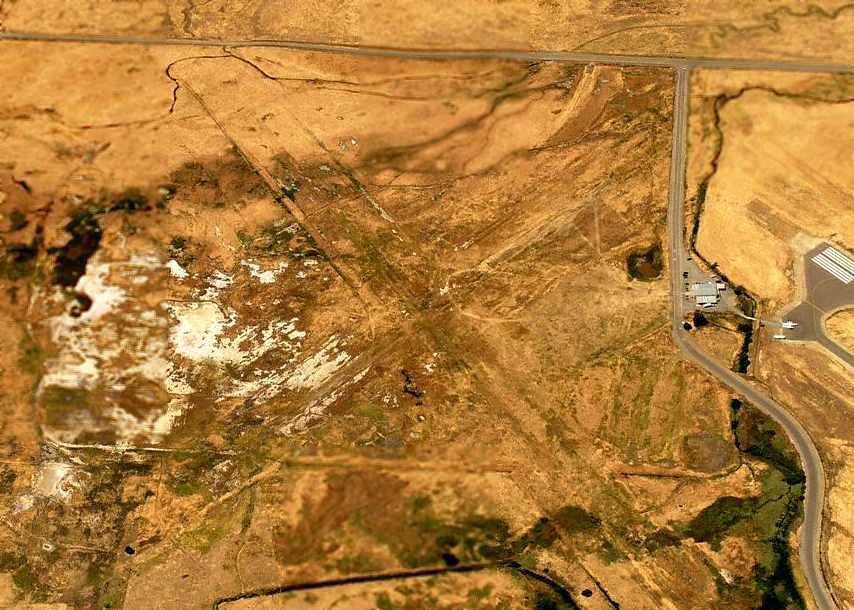
A circa 2006 aerial view looking north at the site of the Byron Airpark
showed that all of the pavement of the 2 former runways had been removed, along with all of the buildings.
Note the runway of the new Byron Airport on the right edge of the photo.
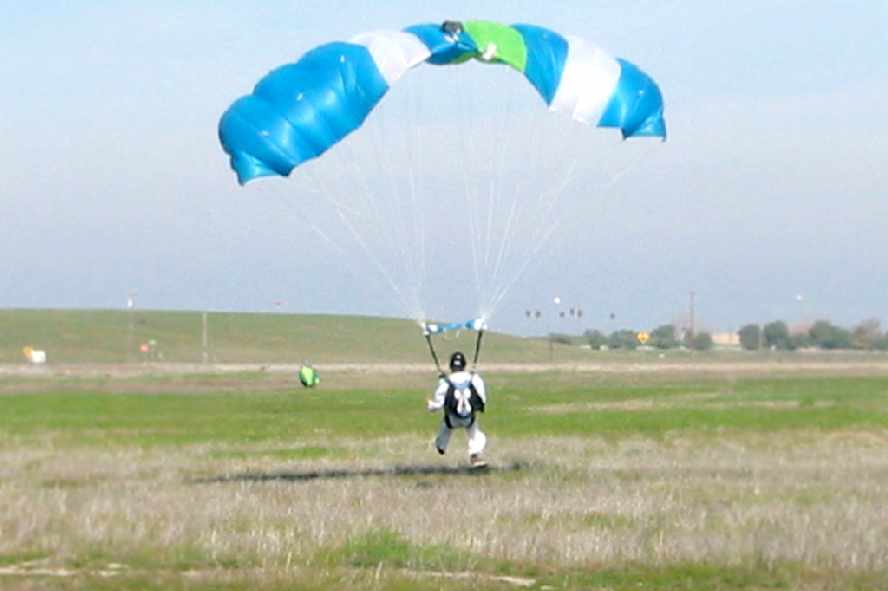
A February 2008 photo by Jonathan Westerling of a skydiver touching down on what used to be Byron Airpark's Runway 22.
Jonathan Westerling reported in 2008, “Today, aviation use of the old Byron Airfield continues to some extent
as the property is the Drop Zone for Bay Area Sky Diving.
A call to their receptionist revealed that they were well aware of the property’s prior use as an airfield.
She mentioned that they are sometimes removing bits of the old runway which poke up out of the ground.
She also stated that the last remnant of the prior airfield,
the segmented circle & runway indicator were lost in a grass fire a few years ago.”

A February 2008 photo by Jonathan Westerling of the windsock at the old Byron Airpark.
According to Jonathan, the windsock “has been restored by Bay Area Skydiving to indicate the wind direction on their drop zone.
The segmented circle which surrounded this windsock was constructed
out of a hundred or more white steel-belted tires which were burned in a recent grass fire.
The rock beyond the windsock is believed to be the remains of the base for the tetrahedron.”

A February 2008 photo by Jonathan Westerling of “All that remains of a building near the hangars of the old Byron Airpark.
The large hangar at the north end of the field was completely removed to make way for the construction of the new County Airport.”

A February 2008 photo by Jonathan Westerling, “Looking up the remains of Runway 32 at the Byron Airpark.
The pavement was plowed under when the airport was decommissioned.”

A February 2008 photo by Jonathan Westerling, “Looking West to the eastern end of Runway 4.”
The site of Byron Airpark is located southwest of the intersection of Armstrong Road & Falcon Way,
adjacent to the west side of the current-day Byron Airport.
____________________________________________________
Discovery Bay Airport, Byron, CA
37.891, -121.621 (East of Oakland, CA)

A 1966 aerial photo depicted the Discovery Bay Airfield
as having a single unpaved northwest/southeast runway.
Photo of the airport while in use has not been located.
This short-lived private airfield may have been related to the construction of the adjacent housing development.
The Discovery Bay Airport was evidently established at some point between 1959-66,
as it was not yet depicted at all on a 1959 aerial photo.
The earliest depiction of the airfield which has been located was a 1966 aerial photo.
It depicted Discovery Bay as having a single unpaved northwest/southeast runway,
but did not depict any buildings or other improvements.
Discovery Bay was not yet depicted at all on the 1966 San Francisco Sectional Chart (according to Chris Kennedy).

Discovery Bay Airport, as depicted on the 1969 USGS topo map.

The only aeronautical chart depiction which has been located of the Discovery Bay Airfield
was on the 1970 San Francisco Sectional Chart (courtesy of Dann Shively).
It depicted Discovery Bay as a private airfield with a 3,000' unpaved runway.
Dann Shively recalled, “When I first started flying in 1972 I tried to explore my local area from the air as much as possible.
I noticed a small strip on my Sectional Chart called Discovery Bay.
Although I never landed there, I flew over it from time to time in the early 1970s.
Nearby is the Discovery Bay development.
It's a man-made series of waterways with all houses having direct water access.
It started small in the 1970's and has grown over the years into a city with more & more waterways being added.
On the southwest corner of the development sat the small dirt or grass field.
I always thought it was somehow connected to the development,
possibly as a place for prospective buyers to land to check out property.”
The only directory listing of the Discovery Bay Airport which has been located
was in the 1976 AOPA Airports USA Directory (according to Chris Kennedy).
It described the field as having a single 3,000' dirt Runway 15/33,
and the field was said to be “Private, Closed to Public.”
The Discovery Bay Airport was evidently closed at some point in 1976,
as it was no longer depicted at all on the 1976 San Francisco Sectional Chart (according to Chris Kennedy),
nor on the 1976 USGS topo map (although it did depict the 1st stages of the adjacent housing development).
A 1979 aerial photo depicted the airfield in basically the same state as that seen in 1966.

The 1993 USGS aerial photo of the airport site
showed the remaining outline of 2 runways (oriented northwest/southeast & north/south).
There was no sign of any buildings having been at the airport site.
Dann Shively reported in 2005, “In the last year or so a shopping center has been built on part of the property.
I flew over it today & you can still see part of the runway on the east side.
Most likely that will soon be gone as development continues in the area.”

A 2005 aerial photo by Dann Shively looking north at the site of the former Discovery Bay Airport,
showed the shopping center covering the western half of the property,
with the remains of the southeast portion of the runway still recognizable.

A 2005 aerial photo by Dann Shively looking northwest at the remains of the runway at Discovery Bay Airport.
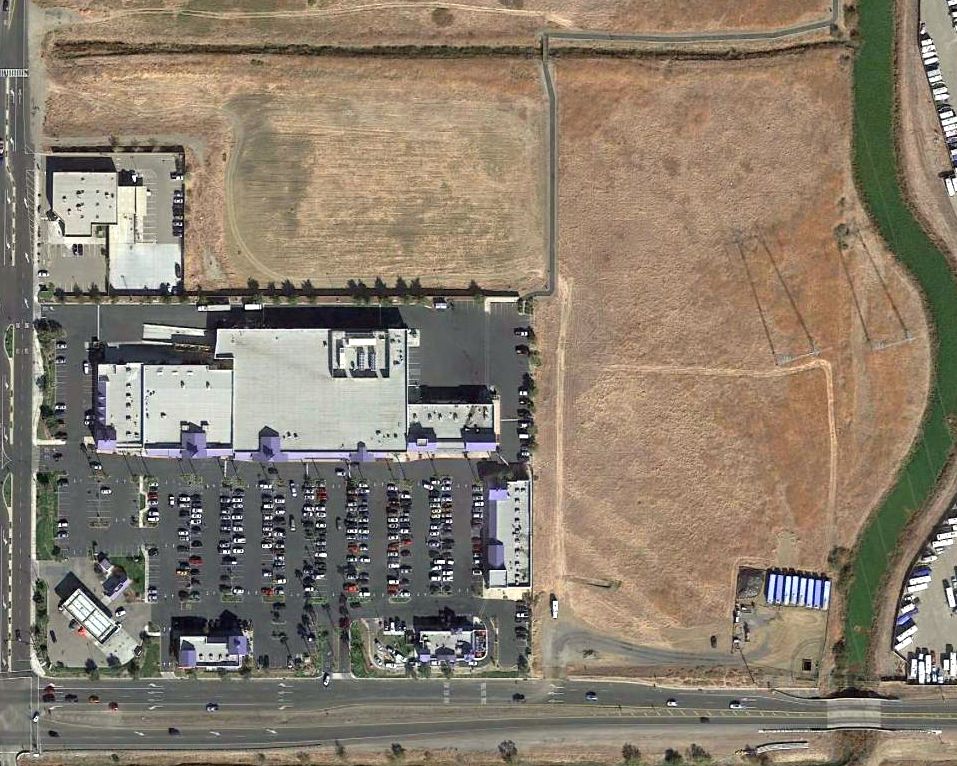
A 2015 aerial view showed that a short portion of the southeast end of the Discovery Bay Airport runway remained barely recognizable.
The site of Discovery Bay Airport is located on the northwest corner of Route 4 & Bixler Road.
____________________________________________________
Knights Airport / Stan's Airpark, Vallejo, CA
38.13, -122.27 (Northeast of Oakland, CA)
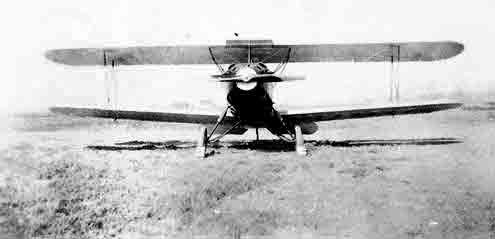
A circa 1936 photo by George Low of his International F-17 at Knight's Airport.
This little airport was known under several names throughout its history.
It was originally known as Vallejo Airport.
According to K.O. Eckland, in 1929, Western Air Lines moved half its equipment from Santa Rosa
and established a flight school at Vallejo Airport.
The airport may have been renamed "Knight" Airport by 1936.
The earliest depiction which has been located of Knights Airport
was a circa 1936 photo by George Low of his International F-17 biplane.
The Airport Directory Company's 1937 Airports Directory (courtesy of Bob Rambo)
described Vallejo Airport as being located "2 miles northwest" of the town of Vallejo.
The field was said to have 3 dirt runways,
with the longest being a 2,500' northeast/southwest strip.
A hangar on the southeast side of the field was described as having "Vallejo" painted on the roof.

The 1939 Sectional Chart (courtesy of Dann Shively)
depicted "Knight" Airport as an auxiliary field.

The 1942 USGS topo map depicted an airport symbol (the propeller) along with the outline of property,
but did not label the airport.
Knights Airport may have been closed for a few years during WW2
(due to wartime security concerns & gas rationing,
as was the case at many other small civilian airports during the war),
as it was not depicted on the 1943 Sacramento Sectional Chart (according to Chris Kennedy)
nor listed among active airfields in the 1945 AAF Airfield Directory (courtesy of Scott Murdock).
At some point between 1945-46, it evidently reopened as "Stan's Airpark",
which was how it was depicted on the 1946 Sectional Chart (courtesy of Dann Shively).
Bill McClinton recalled, “During WW2 as a kid I lived at 34 McNair Street, a couple of blocks from Stan's Airpark.
We called it Knight's I think. I went there frequently, made friends with a WW2 pilot who had a surplus BT-13.
'Helped' him polish it etc. The wing walk guy was known as 'Madman Page';
he had what I believe was a Stearman with clipped wings & a type R985 engine of 400 or 450 hp.
I remember the Mobil gas station either being built or being refurbished shortly after the war ended.
The airport, people & planes made an indelible impression.”

An undated (circa 1946-48) business card for Stan's Airpark (courtesy of Stan Woodman).
Stanley Glenn Woodman recalled, “I was born the son of Stanley Clarence Woodman.
My father either owned or leased & operated the subject airport in the years immediately after World War II.
He named it 'Stan's Airpark' after his own name. He offered flight instruction & charter services.
In 1945 my father took over the airport variously known as Stan's Airpark & Knight's Airport.
Until I saw the information & sectional chart information [on this website],
I had always assumed that my father had built the airfield known to me as Stan's Airpark.
The reason that I believed my father had built the airport is from recollections of what I had heard from my mother
and clear memories that I have of my father framing buildings on the site.
He was building either the hangar, or the burger & beer joint next to the airport (named Faoro's).
Burgers, beer, and shuffle board. I hung around there as a kid - great hamburgers, but don't know about the beer as I was too young.
Another reason is that I had a photo of him (or a worker) on a bulldozer grading the crosswind runway.
The caption on the photo reads 'building the crosswind runway at Stan's Airpark'.”
Stanley continued, “I have memories of my father taking me flying from the airport on its dirt strips.
Even after my parents separated, I hung around the hangar there.
There were always biplanes & other rag-wing aircraft of the era in the hangar, under various states of repair & being repainted.
The smell of the paint dope is strong in my memory,
and whenever I am in a hobby shop & smell model airplane dope, it transports me back to those times.
I recall a number of derelict aircraft on the field, including a couple of Texan AT-6s.
I used to climb around in them & envision myself fighting the enemy in aerial combat.
I also recall once an air show held at the field.
My mother sometimes talked of a wingwalker, who parachuted from the wing of a biplane at the air show.
On that occasion, the wind carried him into a tree or some other obstacle that kept him encumbered until rescued.”

An undated (circa 1946-48) photo of the Mobil Oil service station, burger joint, and hangar at Stan's Airpark (courtesy of Stan Woodman).
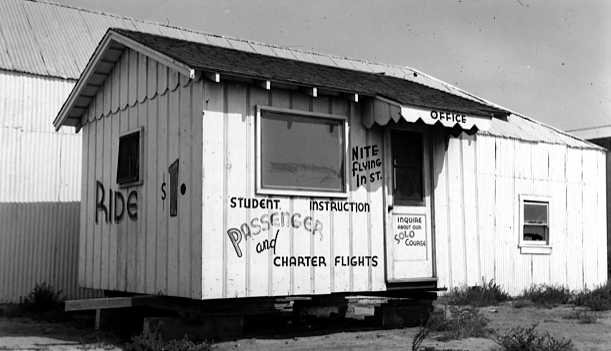
An undated (circa 1946-48) photo of the Stan's Airpark office (courtesy of Stan Woodman).
Stanley Woodman continued, “I believed that the airport was bought by a man named Knight after my father left it.
But if there is evidence that the airport was named 'Knight's' before my father became involved,
then perhaps he had merely leased the property, rather than own it.
Nonetheless, I vaguely recall that the airfield portion of the property was sold off around the time of my parents' divorce.”
According to a 1947 Vallejo Times Herald article (courtesy of Dann Shively),
“Completion of negotiations in the sale of Stan's Air Park, including 4 airplanes & equipment,
to Bill Taylor & Harold Harodyski for $67,000 was announced yesterday
by F.E. Knight & Stan Woodman, the former owners.”
Dann Shively recalled, “It was known as Knight's as long as I knew it growing up.
In fact there was a large painted sign on the hangar facing the road that read 'Knight's' airport."

At some point between 1947-48, the official name of the field apparently reverted to Knights Airport,
as that is now it was labeled on the 1948 Sacramento Sectional Chart (courtesy of Jonathan Westerling).
It depicted the field as having a 2,300' unpaved runway.

A 1948 picture (courtesy of Dann Shively) of Harold Horodyski (Knight's Airport operator),
Al Shively (who had just soloed after just 1.5 hours of instruction), and Russ Moody (Al's instructor).
Dann Shively recalled, "Growing up in Vallejo, I remember as a child when Knight's Airport was still in operation.
My dad, in 1948, as a publicity stunt, soloed an Ercoupe there after only an hour & a half of instruction."

The last photo which has been located showing aircraft at Knights Airport was a 4/18/48 USGS aerial view.
It depicted the field as having 3 unpaved runways,
with a dozen light aircraft parked around a few small buildings on the south side.
The most detailed map depiction of Knights Airport which has been located is the 1949 USGS topo map,
which depicted the field as having a total of 4 runways or taxiways,
with the longest being an 1,800' northeast/southwest strip.
Stanley Glenn Woodman (son of the owner of Stan's Air Park) remarked of this depiction,
“the airfield as having 4 strips... I have difficulty accepting that, as there simply was not enough room in that area to support 3 parallel runways & a crosswind.
As a young boy I used to hike, explore, and hunt that area.
It wasn't very expansive & was very marshy, being part of the Napa River delta.
It was protected by a levee to keep the river on the river side of the wall.”
Stanley Glenn Woodman recalled, “I remember my mother in the early 1950s
talking about the seawall, or levee, breaching, putting the airfield in jeopardy.”

A November 1953 Vallejo Chamber of Commerce map (courtesy of Kevin Walsh) depicted Knight's Airport as having a 2 runways.

The last aeronautical chart depiction which has been located of Knights Airport
was on the 1954 Sectional Chart (courtesy of Dann Shively).
It described Knights as having a 2,200' unpaved runway.
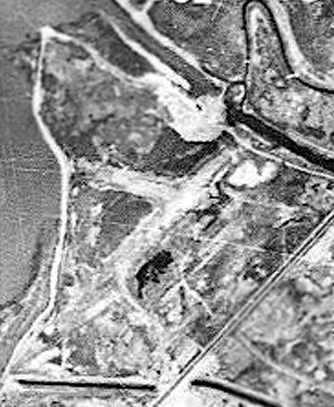
In a 1965 aerial view of Knights Airport (from the Alexandria Digital Library @ UC Santa Barbara, courtesy of Jonathan Westerling)
it was not apparent if the field was still operating at that point.
The 2 runways were quite evident, but the photo was not detailed enough to show any aircraft or other indications of current use.
Knights Airport was apparently closed at some point between 1954-65,
as it was no longer depicted on the June 1965 Sacramento Sectional Chart (courtesy of Ron Kunse)
or on the 1968 USGS topo map.

A 1970 aerial view of the site of the site of Knights Airport (from the Alexandria Digital Library @ UC Santa Barbara, courtesy of Jonathan Westerling)
still showed the remnants of the runways & what appeared to be a hangar still standing of the east side of the field.
Stanley Glenn Woodman (son of the owner of Stan's Air Park) recalled, “Many years later,
after I had become pilot out of Oakland International Airport, I often overflew the old airfield.
As I looked down, I could see the outlines of only 2 runways - a primary plus a crosswind.”
Stanley Glenn Woodman recalled, “In 1983 or 1984 there was a 'perfect storm' combination
of a heavy rainstorm, strong winds and extra high tides that caused a permanent breach in the levee.
This resulted in the entire airfield being covered in water for many years afterwards.”
The 1993 USGS aerial photo of the airport site depicted that
the waters of the Napa River had risen over the site of the former airport.
Dann Shively reported in 2003, "I watched it slowly deteriorate over the years.
The office & hangar disappeared, and the runways were taken over by swamp grass
until a levee broke & the whole area was under water.
Currently the stretch of Sears Point Road (Highway 37, now known as Marine World Parkway)
that was next to the field, is being widened.
Shortly, what was the airport will be under a new roadway."

A 2003 panoramic composite photo by Dann Shively, looking east at the site of Knight's Airport.
Dann visited the site of Knight's Airport in 2003.
"Highway 37 / Sears Point Road / Marine World Parkway is being widened
adjacent to the old Knight's Airport in Vallejo.
There's also an interchange being built just to the west.
I climbed up on what's built so far of the interchange & got a nice shot of the former airport.
I actually stitched 2 shots together for a panorama. The shot is looking east.
That's the Napa River on the left and the highway on the right.
You can see the new section of the highway which isn't opened yet.
That new section partially or wholly covers what was one of the runways that ran along the existing 2 lane road.
As mentioned before it's a wetlands area with marsh grass and tules.
Running along the bottom of the photo is a drainage canal & levee that's evident in your old topo map of the airport."
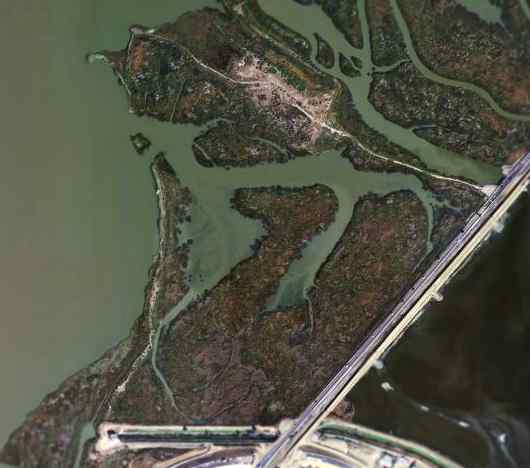
As seen in the February 2004 USGS aerial photo,
the site of the former airport was still submerged under the waters of the Napa River.
However, by comparing the runway layout in the 1949 topo map with the above aerial photo,
it is interesting to note that the land of the former Northeast/Southwest runway
is apparently at a slightly higher elevation than the surrounding terrain, as it was still above water.
The site of Knights Airport is located north of the intersection of Marine World Parkway & Sacramento Street.
Thanks to Chris Kennedy for pointing out this airfield.
____________________________________________________
Vallejo Airport / Mini Airport / Vallejo Sky Harbor Airport, Vallejo, CA
38.155, -122.257 (Northeast of Oakland, CA)
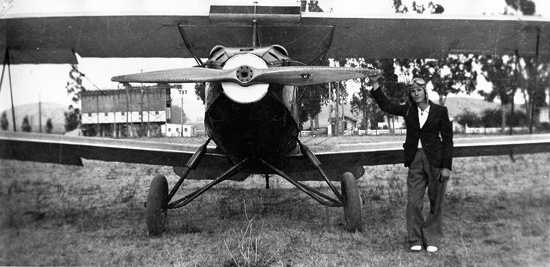
A circa 1936 photo by George Low of a friend in front of George's International F-17 at Mini Field.
The date of construction of this airport has not been determined.
It may have existed as far back as 1929,
as a "Vallejo" Commercial Airport was listed as being located "3 miles due north of Vallejo"
in the Standard Oil Company's 1929 "Airplane Landing Fields of the Pacific West" (courtesy of Chris Kennedy).
It was described as having a 1,500' northeast/southwest runway,
and the "main highway to Sacramento" was said to border the east side of the field.
That description seems to match later map depictions of what eventually became Vallejo Sky Harbor Airport.
By 1936, the airport had apparently been renamed "Mini" Airport.
The earliest depiction which has been located of Mini Airport
was a circa 1936 photo by George Low of a friend in front of George's International F-17 at Mini Field.
Dann Shively recalled, "The Mini family owned most of the property in that area.
In fact, the site of the airport is near what is now Mini Drive."

The 1939 Sectional Chart (courtesy of Dann Shively)
depicted “Mini" Airport as an auxiliary airfield.

The 1942 USGS topo map depicted an airport symbol (the propeller) along with the outline of property,
but did not label the airport.
The Vallejo Airport may have been closed for some period of time during WW2
(like many other small civilian airports, due to wartime security concerns),
as it was not depicted on the 1943 Sacramento Sectional Chart (according to Chris Kennedy)
nor listed among active airfields in the 1945 AAF Airfield Directory (courtesy of Scott Murdock).
The airport was evidently reopened at some point between 1945-46,
as it was depicted as "Sky Harbor" on the 1946 Sectional Chart (courtesy of Dann Shively).

The 1948 Sacramento Sectional Chart (courtesy of Jonathan Westerling)
depicted the "Vallejo Sky Harbor" Airport as having a 2,500' unpaved runway.
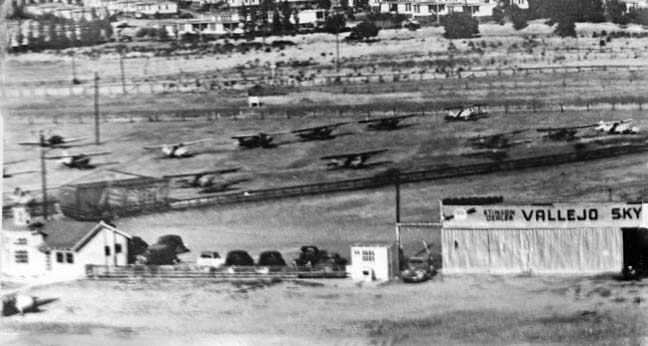
A circa late 1940s view looking northeast at Sky Harbor Airport (courtesy of Dann Shively),
showing over a dozen single-engine aircraft & a hangar.
Dann observed, “The railroad tracks & the highway run left to right between the planes & the houses in the background.”

The last photo which has been located of Vallejo Sky Harbor Airport was a 3/3/48 USGS aerial view.
It depicted the field as having a single northeast/southwest runway with a parallel taxiway,
Over a dozen single-engine aircraft a few small buildings were visible on the east side.
The most detailed map depiction of Vallejo Sky Harbor which has been located is the 1949 USGS topo map,
which depicted the field as having a total of four 1,800' runways or taxiways.
Two buildings or hangars appear to have been located east of the runway intersection.
A propeller decal, undated, from Vallejo Sky Harbor Airport (courtesy of Dann Shively).
The last depiction which has been located of Vallejo Sky Harbor
was on the 1949 Sectional Chart (according to Dann Shively).
Vallejo Sky Harbor was apparently closed (for reasons unknown) at some point between 1949-54,
as it was no longer depicted at all on the 1954 Sectional Chart (courtesy of Dann Shively).
Dann Shively recalled, "I grew up in Vallejo & have been flying around the area as a broadcast news pilot for nearly 30 years.
When I was 11, in 1957, we moved to a house that was within a mile or so of the Sky Harbor Airport site.
Of course it was long gone by then & was covered by tract houses built in the 1950s.
We've lost a lot of airports!"
A 1987 aerial photo of the site showed that it had been completely covered by houses.

A 2016 aerial view showed the site of Vallejo Sky Harbor had been completely covered by houses, with not a trace remaining of the little airport.
According to Dann Shively, the site of Vallejo Sky Harbor is located northwest of the intersection of Route 29 & Mini Drive.
Thanks to Chris Kennedy for pointing out this airfield.
____________________________________________________
Sherman Field, Pleasant Hill, CA
37.95, -122.057 (Northeast of Oakland, CA)

Sherman Field, as depicted on a 8/5/43 aerial view looking north from the 1945 AAF Airfield Directory (courtesy of Scott Murdock).
According to K.O. Eckland, a 107-acre tract at the intersection of Monument Boulevard & North Main Street
was purchased by Chester Dickson in 1941.
The initial airfield consisted of a 2,150' dirt runway.
The field was named for Dr. Samuel Sherman, who helped finance the field.
A postmark commemorated the 5/11/41 Dedication of Sherman Field.
A collection of photographs has a picture of the airport from 1941.
Sherman Field was used by PAA starting in 1942 for navigation & instrument flight training
with 2 Stinson Reliants & a Waco VKS-7.
A 8/5/43 aerial view looking north from the 1945 AAF Airfield Directory (courtesy of Scott Murdock)
depicted Sherman Field as having a single northeast/southwest unpaved runway,
with 2 hangars along the southwest side.
The earliest aeronautical chart depiction which has been located of Sherman Field
was on the 1943 Sacramento Sectional Chart (according to Chris Kennedy).

The August 1944 Regional Aeronautical Chart (courtesy of Jonathan Westerling)
depicted Sherman as a municipal/commercial airport.
The use of Sherman Field by PAA for navigation & instrument flight training ended in 1944.

A 1946 aerial view depicted Sherman Field as having 2 runways in an X-shape,
with 2 hangars & several aircraft on the southwest side of the field.
What were the 6 circular items located in the grass in between the runways?
The 1947 USGS topo map depicted Sherman Field as having two 2,800' runways,
and a ramp at the southwest corner with 2 hangars.
K.O. Eckland recalled that "Sherman Field was where I checked out in a PT-22
to qualify for my civil ticket after discharge from USAF in 1947."

A 1948 aerial view looking northwest at the ramp & hangars at Sherman Field
(courtesy of Bill Larkins, who lives adjacent to the site of the airport).
The 1948 Sacramento Sectional Chart (courtesy of Jonathan Westerling)
depicted Sherman as having a 2,800' unpaved runway.
A 1949 aerial view showed that a drive-in movie theater had been squeezed in just to the west of the runway intersection.

A circa late 1940s aerial view looking southwest a Sherman Field showed the drive-in movie theater squeezed in just to the west of the runway intersection,
a dozen planes parked near the hangars, and one plane at the runway intersection.

The last aeronautical chart depiction which has been located
of Sherman Field was on the 1949 Sacramento Sectional Chart (courtesy of Kevin Walsh).
It depicted Sherman as having a 2,600' unpaved runway.
Sherman Field was still depicted on the 1949 USGS topo map.

The last depiction which has been located of Sherman Field
was an undated aerial view looking north from the 1950 Air Photo Guide (courtesy of Kevin Walsh).
The guide described Sherman Field as having 2 runways: 3,000' Runway 10/28 & 2,800' Runway 18/36.
It listed the manager as Phillip McManamy.
Sherman Field was sold in 1950 for real estate development.
The last reference to Sherman Field still being in operation came from Norman Nielsen,
who recalled, “In 1951, at the age of 3, I moved to Gregory Gardens, now Pleasant Hill,
and have some vague remembrances of Sherman Field,
in particular that there was a hangar on the south side of Monument Boulevard
and that planes would sometimes taxi across the road to reach the runway.”
Sherman Field was evidently closed at some point between 1951-52,
as a March 1952 Thomas Brothers map (courtesy of Kevin Walsh) showed a grid of new residential streets had been covered the site.
A 1953 street map (courtesy of Kevin Walsh) showed residential streets covering the site of Sherman Field,
including one named Sherman Drive.
A 1958 aerial view showed that the hangars had been removed,
and houses covered most of the property of Sherman Field.
Ironically, the northeast/southwest runway still remained largely intact, with houses all around it,
as it would eventually form the alignment for the 680 Freeway which would pass through the site in a few years.
A 1968 aerial view showed that the 680 Freeway had been built right through the center of the former airport property,
and the location of the hangars had been redeveloped as well,
erasing any trace of the former Sherman Field.

As an be seen in the February 2004 USGS aerial photo,
the 680 Freeway has been built through the center of the site,
and not a trace of the former airport appears to remain.
Sherman Field was located northeast of the intersection of Contra Costa Boulevard & Monument Boulevard.
____________________________________________________
Concord Airport (original location), Concord, CA
37.97, -121.995 (Northeast of Oakland, CA)

An undated aerial view looking south at the original Concord Airport by A.W. Stevens, from a 1926 magazine article (courtesy of Neil Hinckley).
The caption read, “This is the main western terminus of the transcontinental Air Mail line.
Eastbound mail leaves from this field.
Westbound, the mail plane flies directly to Crissy Field, on the edge of San Francisco,
unless prevented from landing there by bay fog.
From Concord Field to Crissy Field is only about 20 minutes by air.”
The original airport for the town of Concord was located on the east side of the town.
According to a circa January 1986 article in the Concord Gazzette (courtesy of Phil Beutel),
the airport was dedicated as the “Diablo Air Mail Terminal” on 2/7/1925.
Concord was declared by the U.S. Postal Service to be the West Coast terminus for cross-country airmail flights.
Airmail planes flew into the Concord field to deliver & pick up mail
that was carried back & forth from San Francisco & Oakland on trains.
The January 1926 issue of the National Geographic magazine featured a picture of the airfield
in a story describing the new airmail service.

Two 1926 photos of the new hangar at Concord Airport, when the Air Mail terminal was transferred from Crissy Field (courtesy of Kevin Walsh).

The Concord “Air Mail Field”, as depicted on the March 1928 CA State Automobile Association map (courtesy of Kevin Walsh).

The location & layout of the “Concord Air Mail Field”
from the 7/19/26 Department of Commerce Aeronautical Bulletin (courtesy of Jonathan Westerling).
It described the field as measuring 2,000' northeast/southwest by 2,000' northwest/southeast,
with Air Mail hangars on the northwest side of the field.

A circa 1920s photo (courtesy of Bill Larkins) of 3 unidentified men in front of a DH-4 & a hangar at the original Concord Airport.
The 1927 Standard Oil of CA Airport Directory (courtesy of Chris Kennedy)
described Concord Airport as a “permanent” field, located 2 miles southeast of the city.
It was said to consist o a 2,600' x 2,200' field,
which permitted landings in any direction.
Hangars were said to be located at the northeast corner.
It was also noted that “This field is used by the United States Air Mail
and is to be used for emergency only.”
According to a circa January 1986 article in the Concord Gazzette (courtesy of Phil Beutel),
Concord's role as the West Coast Airmail terminus lasted until 1927,
when new airmail contractor Boeing Air Transport moved the terminus to San Francisco.
But even then Concord still saw some airmail use,
as the San Francisco Airport was frequently fogged-in.
As private companies were taking over the airmail service,
it was possible for the same planes to begin carrying passengers.
Boeing's 1st passenger flight out of Concord was recorded on July 1, 1927 in a local newspaper.
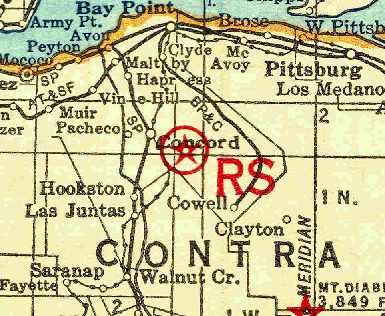
The earliest chart depiction of the Concord Airport which has been located
was on the 1929 Rand McNally Air Trails Map (courtesy of Chris Kennedy).
It depicted an intermediate field just southeast of Concord.
It was described as an “Emergency” field, “open to private planes for emergency only.”
It was said to consist of an 80-acre earthen field, measuring 2,200' square,
with 2 hangars on the northwest side.
According to a circa January 1986 article in the Concord Gazzette (courtesy of Phil Beutel),
Clothidle Larkin recalled that the field was rededicated in the early 1930s.
The role of the Concord Airport was apparently shifted to that of an Intermediate Field at some point between 1929-33,
as it was listed in The Airport Directory Company's 1933 Airport Directory (according to Chris Kennedy)
as the Department of Commerce's Intermediate Field Site 2A,
along the San Francisco – Salt Lake City Airway.
The field was said to consist of an 81-acre black loam field,
along with hangars.

The 1933 San Francisco Airway Map (courtesy of Chris Kennedy)
depicted Concord as Site 2A.
The original Concord Airport was no longer listed at all in the 1934 Department of Commerce Airport Directory (according to Chris Kennedy),
or in The Airport Directory Company's 1937 Airport Directory (courtesy of Bob Rambo).
However, the field was still being used in the “late 1930s”, according to Phil Cox,
a charter member of the Concord Flying Club.

A circa late-1930s photo (courtesy of Bill Larkins) of an unidentified group (airmail pilots?)
in front of a Boeing 40A & a hangar at the original Concord Airport.
Nick Lines recalled, “I attended Clayton Valley Elementary School in the late 1950s located on the Southeast border of the airfield.
My 3rd grade teacher recalled mail planes landing & taking off over the school house.”

In a 1939 aerial view of Concord Airport (from the Alexandria Digital Library @ UC Santa Barbara, courtesy of Jonathan Westerling)
it is not apparent if the field was still operating at that point.
The original Concord Airport was not depicted at all on the December 1941 San Francisco Sectional Chart (according to Chris Kennedy),
or on the 1942 USGS topo map.
World War 2 brought an end to the original Concord Airport,
when the Sheriff removed the propeller from the Concord Flying Club's plane (due to wartime security concerns).
The aircraft was stored in a barn for the next 4 years.

In a 1946 aerial view of Concord Airport the field was still clear, but there was no obvious indication if it was still operational as an airfield.
The hangar was visible along the northwest side of the field.
A 1949 aerial view showed the site unchanged from as seen in 1946,
with the airfield remaining completely clear.
Phil Beutel recalled, “I purchased Niagra Duplicator in 1950.
The lease on the hangar came with the business & the owner was a Mr. Nulty.
When I leased the hangar the land was all vacant except for a few houses on Clayton Road.”
Nick Lines recalled, “I attended Clayton Valley Elementary School in the late 1950s located on the Southeast border of the airfield.
The brick hangar building on West Street was a machine shop during the 1950s & 1960s.”
Neil Hinckley recalled, “Our (1950) housing development, 'Concord Village', was built over” the site of the airfield.
A 1958 aerial view showed that housing had covered about half of the site of the Concord airfield.

A February 1962 aerial view by Neil Hinckley looking northwest at the remains of the Concord Airfield.
Neil observed, “Clayton road at left. What remains of the airfield in 1962 is at upper right...
the encroachment of suburban housing units is almost complete.
There was an earthen berm around the field, and in a year or two the portion visible in this photo would become Eichler Homes.”
A 1966 aerial view showed that housing had filled in the remainder of the site of the Concord airfield,
with the exception of the former hangar, which remained standing along the northwest side of the field.
A 1979 aerial view showed the former Concord hangar was still standing.

A undated photo of a remaining hangar from the original Concord Airport,
from a circa January 1986 article in the Concord Gazzette (courtesy of Phil Beutel).
The article said the hangar was used in recent years by a battery exchange company,
and was also used as a warehouse.
However, it had fallen into disuse, and was the subject of complaints from neighbors.
Brett McCoy recalled, “As a youth in the mid 1980s I attended Concord United Methodist Church
which was across the street from the hangar [of] the original airport of Concord.
It was indeed dilapidated but was the home of 'California Battery X-Change' as indicated by a hand-painted sign.
It the focus of much curiosity. At that time, there was still maybe 5 or 10 acres of undeveloped land behind it.
It was considered an eyesore in the middle of a residential neighborhood.”
The hangar was evidently removed at some point between 1979-88,
as a 1988 aerial view showed the site of the hangar had been wiped clean,
and a 1993 aerial view showed that more houses had been built on the location.

As seen in the 2004 USGS aerial photo,
the site of the original Concord Airport has been densely covered in housing,
and not a trace appears to remain of the old airfield.
Phil Beutel reported in 2005, “The last I heard there was a bronze marker near the intersection of West & Chestnut.”
Neil Hinckley reported in 2005, “500 houses & a school now cover that 2,200' x 2,600' grass field.”

A pre-2009 photo by Bill Larkins of the historical marker commemorating the original Concord Airport.
Bill Larkins reported in 2009 that the Concord Airport historical marker “has since been moved or removed & I can't find it now.”
According to Phil Beutel, Concord Airport was bounded on the west by West Street, on the north by Wilson Lane,
on the east by Denkinger Road, and on the south by Clayton Road.
____________________________________________________
Concord Naval Weapons Station Airfield, Concord, CA
37.99, -122.017 (Northeast of Oakland, CA)
A 1943 photo by Bill Larkins of an F6F Hellcat at OLF Concord.
This military airfield was located on the southern edge of the Concord Naval Weapons Station.
The Concord Naval Weapons Station Airfield was evidently constructed at some point between 1939-43,
as it was not yet depicted on a 1939 aerial photo.
The earliest depiction which has been located of the NWS Concord Airfield
was a 1943 photo by Bill Larkins of an F6F Hellcat at OLF Concord.
Bill recalled, "This F6F (BuNo 40198) was there one day in October 1943 when I was home on leave
and hung out in the weeds with my Graflex.
Other planes there that day were a Cessna JRC-1, North American SNJ-4,
Beech SNB-1, Beech SNB-2C, Douglas SBD-5 and a Grumman F4F-3.
Alameda operated the Outlying Field Concord for practice takeoffs & landings."
A 1944 USN aerial view looking southwest at OLF Concord (courtesy of Bill Larkins).

The August 1944 Regional Aeronautical Chart (courtesy of Jonathan Westerling)
depicted the Concord Navy Airfield as an auxiliary airfield.

The 1945 AAF Airfield Directory (courtesy of Scott Murdock) described “Alameda NAS Auxiliary (Concord Outlying Field)”
as a 300 acre irregularly-shaped property having 2 asphalt runways, the longest being the 4,000' north/south strip.
The field was not said to have any hangars.
By the time of the 1946 Sectional Chart (courtesy of Dann Shively),
the Concord Navy Airfield was still depicted,
but its depiction on the chart had been downgraded to that of an auxiliary airfield.

A 1946 aerial view depicted OLF Concord as having 2 paved runways,
with a paved ramp on the southeast side.
There were no buildings or aircraft visible on the field.

The last aeronautical chart depiction which has been located
of the Concord Navy Airfield was on the 1948 Sacramento Sectional Chart (courtesy of Jonathan Westerling).
It depicted “Concord” as having a 4,000' hard-surface runway.
Strangely, the airfield was not depicted with any military label,
so it is possible that it may have been (briefly) relinquished for civilian use.
The Concord Navy airfield was evidently closed at some point between 1948-49,
as it was no longer depicted as an active airfield on the 1949 Sectional Chart.
A 1949 aerial view showed that 2 prominent closed-runway “X” symbols had been painted on the ends of the east/west runway,
and the north/south runway was being used for storage of trailers.

The photo which has been located showing the Concord Navy Airfield remaining intact was an undated aerial view looking west from a circa 1950s real estate brochure (courtesy of Kevin Walsh).
Concord's 2 paved runways remained intact, but were being used for some type of non-aviation storage.

The Concord NWS airfield was depicted on the 1959 USGS topo map (courtesy of Kevin Walsh), but it was not labeled,
which presumably means it was no longer an active airfield at that point.
The Concord airfield was depicted as having 2 paved runways (the largest was 3,300' long), taxiways, and a ramp.
A 1959 aerial view was the last photo located which showed the entire length of both runways remaining intact.
A 1966 aerial view showed that construction of new roads & buildings
had eaten away at some of the length of the southern end of the north/south runway,
The 1993 USGS aerial photo showed that the primary (east/west) runway & parking ramp still existed,
but the majority of the north/south runway had been removed,
with a residential development having been built at some point between 1988-93
over the northern portion of the former north/south runway.
The Concord Naval Weapons Station itself was placed in a "reduced operation status" in 1999.
The station is presently surrounded by dense residential development.
A 2003 photo by Jonathan Westerling looking east along a remaining runway of the former Concord NWS airfield.
A 2003 photo by Jonathan Westerling looking south along a remaining runway of the former Concord NWS airfield.
Jonathan Westerling visited the Concord NWS airfield in 2003.
His report: "The trees at the ends of the runways at the Concord Naval Weapons Station have grown to well over 35' high.
Even though it has been inactive for a long time, the field itself is still very much in evidence,
and fresh yellow X's have been painted on the asphalt runways.
The east/west runway is in better condition than the north/south runway which is mostly overgrown.
Near the runway intersection, a Naval housing complex 'Victory Village' was constructed,
though the buildings are almost completely empty.
No other present day reuse of the airfield is evident, though the property is completely fenced off.
The runways can be easily seen from East Olivera Road."

As seen in the February 2004 USGS aerial photo,
the majority of the primary (east/west) runway & parking ramp still existed,
but a residential development had been built over a northern portion of the north/south runway.
Ironically, in 2005 the Mayor of Concord, Laura Hoffmeister,
was lobbying the Defense Department to close the Concord Naval Weapons Station,
according to an Associated Press article by Michelle Locke (courtesy of Jonathan Westerling).
At a time when many other municipalities are desperately trying to avoid having their bases closed,
the Concord Mayor is trying to clear the way for 13,500 new homes,
planned for the property of the Navy base.
Marshall Carter reported in 2005 that the plan has been reduced to 6,000 houses over the former airfield site,
due to concerns about low-level radiation contamination on other parts of the former Navy facility.

A 2014 aerial photo showed the site of the NWS Concord Airfield remained in much the same configuration as seen in 2004.
____________________________________________________
San Francisco Bay Airdrome, Alameda, CA
37.785, -122.282 (East of San Francisco, CA)

In 1920, as part of an inheritance from a wealthy alumnus,
the University of California received 458 acres of partially filled marshland on both sides of Webster Street.
In 1929, capitalizing on the airplane fever created by Lindbergh's transcontinental flight,
the UC Regents began construction of an airport.
The marsh was drained by a network of ditches from which water was pumped.
After grading the site, crushed oyster shells were barged from Bay Farm Island to pave 3,400' & 1,700' runways,
and the airdrome's business was housed in a single 53,000-square-foot hangar, constructed for $150,000.

An undated photo of a large gathering in front of the San Francisco Bay Aerodrome hangar, possibly for its 1930 dedication.
The Bay Airdrome had its gala christening party in 1930.
The airfield was a busy place,
as an early home base for Coastal Air Freight, Varney Air Lines, West Coast Air Transport,
Western Air Express, the transbay Air Ferries, and Boeing's Pacific Air Transport.
The Standard Oil Company's 1930 "Airplane Landing Fields of the Pacific West" (courtesy of Chris Kennedy)
described San Francisco Bay Airdrome as having 2 shell runways,
with the longest being a 3,400' east/west strip.
A 3,600' northeast/southwest runway was listed as being under construction, to be ready in 1931.
San Francisco Bay Airdrome's success during 1930-31 led to a 160' addition to the original hangar & the first 160' of another one.
Three more hangars were soon added, actually attached to the first,
then a 5th one, separate & canted at an outward angle.

The earliest map depiction which has been located of San Francisco Bay Airdrome
was on a February 1931 CA State Automobile Association map (courtesy of Kevin Walsh).
It also depicted the nearby Alameda Airport to the west.

A pre-1933 Bekins Van & Storage map, by Thomas Brothers Maps (courtesy of Kevin Walsh)
did not yet depict anything at the site of San Francisco Bay Airdrome,
although the adjacent Alameda Airport was depicted to the west.

“San Francisco Bay” was depicted as a commercial/municipal airport
on the 1933 San Francisco Airway Map (courtesy of Chris Kennedy).
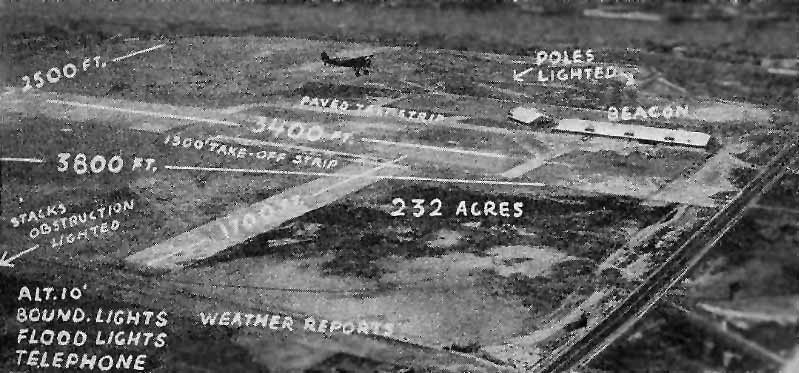
An aerial looking northwest at San Francisco Bay Airdrome,
from The Airport Directory Company's 1933 Airports Directory (courtesy of Chris Kennedy).
Note the aircraft in flight over the center of the field.
The directory described San Francisco Bay Airdrome as having 2 crushed shell runways
(extravagantly described as "one of the finest surfaces ever constructed for airplane landings"),
oriented 3,400' east/west & 1,700' north/south.
The field featured a "modern steel hangar", fueling, passenger waiting room, and "expert mechanical service".
The manager was listed as R.U. St. John.

San Francisco Bay Airdrome, as depicted on a circa 1935 Bekins Van & Storage map, by Thomas Brothers Maps (courtesy of Kevin Walsh),
along with the adjacent Army Air Base Benton Field, and Pan American Airways Inc.
A 1936 airport directory described San Francisco Bay Airdrome as having four runways,
with the longest being a 3,600' crushed shell northeast/southwest runway.
A blimp anchorage was located on the southwest part of the field.

A 1937 aerial view of the San Francisco Bay Airdrome (courtesy of aerofiles.com).

An aerial view looking northeast at San Francisco Bay Airdrome,
from The Airport Directory Company's 1937 Airports Directory (courtesy of Bob Rambo).
The directory described San Francisco Bay Airdrome as having 2 crushed shell runways (3,400' east/west & 1,700' north/south)
and 2 graded runways (3,600' northeast/southwest & 2,500' north/south),
and an asphalt takeoff strip on the east/west runway.
A 1938 photo (courtesy of Bill Larkins) of a Condor Air Lines Consolidated "Fleetster" 20-A in front of the boarding area at SFBA.
Condor Air Lines started a route to Monterey with this plane.
It's still in it's TWA red colors - it was repainted yellow the next year.

An undated (circa 1930s?) photo of 2 monoplanes & a biplane in front of the SFBA hangar.
The original caption was “San Francisco Bay Aerodrome, the busiest airport in the world.”
Airline business at the field was negatively impacted by the depression-era economy,
and the airlines soon departed to the San Francisco & Oakland Airports.
The Airdrome became home to general aviation & a number of operators,
including Johnston Air Service, Monarch Air Service, Pacific Aerial Survey,
dealerships for Stinson, Waco, Stearman-Hammond, Kinner, and Fairchild airplanes,
and the business fleets of Standard, Mohawk, and Richfield oil companies.

A 1938 street map (courtesy of Kevin Walsh) depicted “Alameda Airport & Seaport”, “Benton Field”, and “San Francisco Bay Airdrome”.
Aerial extravaganzas in 1938 & 1939 attracted tens of thousands of locals to their airfield.
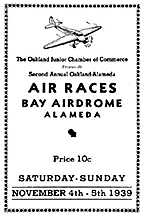
A program for the 11/4/39 Air Races at the “Bay Airdrome, Alameda”.
K.O. Eckland recalled, "SFBA is where I grew up, the classic kid riding his bike
from Berkeley all the way to Alameda after school let out & on weekends just to be around airplanes."

A 1939 photo by Bill Larkins of Paul Mantz's Lockheed Orion 9-C at San Francisco Bay Airdrome.
A undated photo of Tex Rankin in his Grear Lakes biplane in front of the hangars at SFBA (courtesy of Bill Larkins).
Bill Larkins recalled, "It had unique hangars & in addition they were different in having advertising painted on the roofs.
A fascinating place!"
A list of aircraft registered as being based at the Airdrome from 1931-40 included aircraft by
Aeromarine-Klemm, Aeronca, Alexander Eaglerock, American Eagle, Bach, Beechcraft, Buhl,
Consolidated, Curtiss, De Havilland, Fairchild, Fleet, Fokker, Keystone, Kinner, Lockheed,
Luscombe, Monocupe, Piper, Porterfield, Ryan, Rearwin, Savoia-Marchetti, Security Airster,
Sikorsky, Stearman, Stinson, Swallow, Taylor, Taylorcraft, Travel Air, Viking, and Waco.
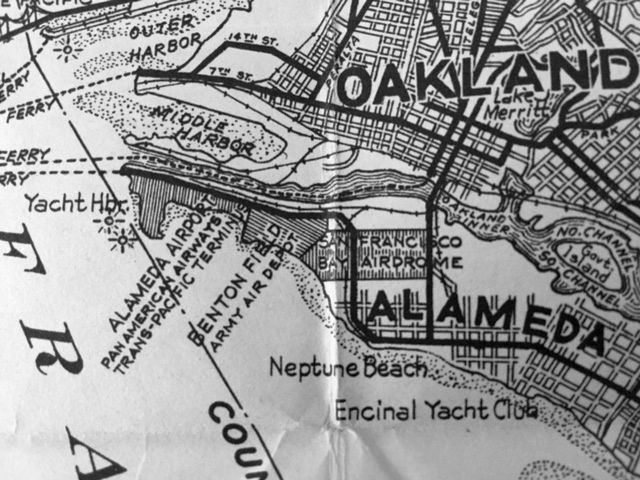
A January 1940 Metsker map (courtesy of Kevin Walsh) depicted “Alameda Airport, Pan American Airways Trans-Pacific Terminys”,
“Benton Field, Army Air Depot”, and “San Francisco Bay Airdrom” all in a row on the peninsula,

A circa 1940 Thomas Brothers map (courtesy of Rex Ricks) depicted the “San Francisco Bay Airdrome Inc.” on the east side,
the “Army Air Base Benton Field” in the center,
and the “Alameda Airport Inc.” on the west end of the peninsula.
Two buildings were depicted along the northeast side of the San Francisco Bay Airdrome.

The last aeronautical chart depiction of San Francisco Bay Airdrome which has been located
was on the December 1941 San Francisco Sectional Chart (courtesy of Chris Kennedy).
The new Alameda Naval Air Station had recently been constructed adjacent to the west side of the Airdrome,
and the naval airfield's significant expansion soon spelled the end for the little civil airport.
The Bay Airdrome was closed in 1941 when it was decided that its traffic interfered with operations at NAS Alameda.
The Navy first condemned 70 acres bordering Atlantic Avenue for a housing project,
then ordered the abandonment of the Airdrome.
The 1942 USGS topo map still depicted the San Francisco Bay Airdrome,
but the adjacent NAS Alameda was simply left blank (without any depiction of the airfield at all),
simply labeled "Military Reservation".
This was omission was apparently due to security concerns during WW2.
The Airdrome was no longer depicted at all on the 1946 USGS topo map
or the 1946 Sacramento Sectional Chart (courtesy of Dallam Oliver-Lee).

A 1946 aerial photo showed that both hangars from the Airdrome remained standing,
but several buildings & parking lots had been constructed over its former airfield area.

By the time of the 1949 USGS topo map,
the open airfield area of the former Airdrome had been filled in with buildings.

A 1958 aerial view showed that both former hangars from the former San Francisco Bay Airdrome remained standing.
A 1959 aerial view showed that the large former SFBA hangar had been removed at some point between 1958-59,
but the smaller hangar (on the west) remained standing.
In 1970, the College of Alameda opened on the eastern portion of the former Airdrome property.
A 1993 photo by Bill Larkins of one of the former hangars of San Francisco Bay Airdrome.
Bill Larkins reported that the former hangars of SFBA still existed as of 2003.
"They were moved by the Navy & still belong to them.
Most are abandoned but one is being used as a Navy medical supply warehouse."
Rick Turner reported in 2003, "I went by today
and the 2 hangars that had been moved are gone
along with some other ex-Navy warehouses.
It looks like some construction will start there soon but I don't know what.
The one hangar that was still in it's original position
is still there & appears to be being used for some sort of storage."

A February 2004 USGS aerial photo of the site of the former Airdrome.
The last hangar from the former Airdrome was evidently removed at some point between 2004-2006,
as a 2006 aerial photo showed that it had been replaced by new housing.

A 5/11/16 photo by Kevin Walsh of the site of San Francisco Bay Airdrome.
The site of the former Airdrome is located northwest of the intersection of Webster Street & Atlantic Avenue.
Thanks to Chris Kennedy for pointing out this airfield.
See also: http://www.aerofiles.com/SFBA/SFBA.html
____________________________________________________
Alameda Airport / Benton Field / Alameda NAS (NGZ), Alameda, CA
37.785, -122.315 (West of Oakland, CA)

Alameda Airport & Seaplane Base,
as depicted on the 1929 "Rand McNally Standard Map of CA With Air Trails" (courtesy of Chris Kennedy).
In 1927, an airfield was built at Alameda with one east/west runway, 3 hangars,
an administration building, and a yacht harbor.
The Standard Oil Company's 1929 "Airplane Landing Fields of the Pacific West" (courtesy of Chris Kennedy)
described Alameda Airport as being operated by Curtiss Airport, Inc.
The airfield configuration was said to be a 2,600' east/west runway,
along with the comment, "Field to be enlarged to 5,400' x 3,400'."
A total of 10 hangars, a repair shop, weather bureau, and a hotel were listed as being along the north side of the field.
By 1930, the Army had established Benton Field adjacent to the east side of Alameda Airport.

Alameda Airport was depicted on the February 1931 CA State Automobile Association map (courtesy of Kevin Walsh) as occupying a narrow peninsula.
It also depicted the nearby San Francisco Bay Airdrome to the east.

A remarkable 1932 aerial view looking west, with Alameda Airport in the foreground at lower-left,
with the San Francisco skyline at the upper-left (courtesy of Bill Eaton).
Bill observed, “Alameda Airport is at lower left along the south side of the Oakland estuary- the dark channel at lower left.
Goat Island, later renamed Yerba Buena, is at center & the old Key System streetcar/ferry pier is at far right.
No Bay Bridge yet in 1932 so the ferries crowd the bay.
Large Southern Pacific railhead & ferry piers are at lower center
and 2 more ferry operators have piers on each side of the mouth of the estuary.”

Alameda Airport, as depicted on a pre-1933 Bekins Van & Storage map, by Thomas Brothers Maps (courtesy of Kevin Walsh).
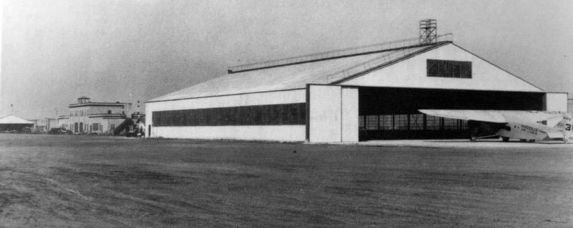
An undated (circa 1930s?) photo captioned “Maddux Air Line - Alameda Airport, All steel building by Herrick Iron Works, Oakland” (courtesy of Kevin Walsh).

“Alameda” Airport, as depicted on the 1933 San Francisco Airway Map (courtesy of Chris Kennedy).
Over the next few years, the City of Alameda continued to expand the area of the airport by filling in land in the bay.
Pan American Airlines took over the yacht basin in 1935
and inaugurated flying boat service to Hawaii & the Orient.

A circa 1935 Bekins Van & Storage map, by Thomas Brothers Maps (courtesy of Kevin Walsh)
depicted the facilities of Pan American Airways Inc., along with the adjacent Army Air Base Benton Field, and San Francisco Bay Airdrome.
The City of Alameda deeded the airfield property to the Federal Government in 1936,
and the Army turned over its facilities at Benton Field to the Navy.
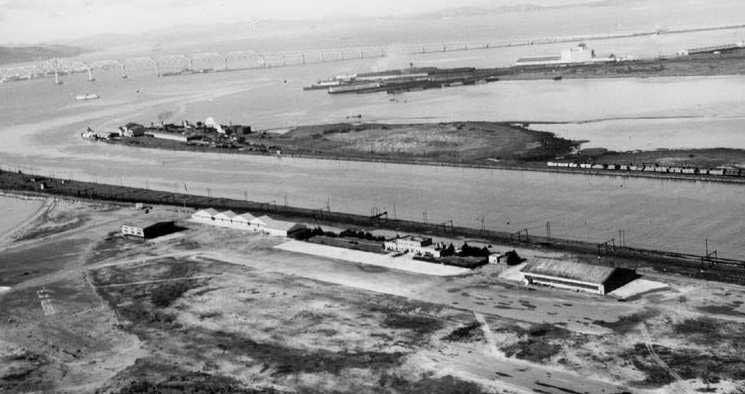
A 1937 photo of Alameda Airport (courtesy of Bill Larkins).

A 1938 street map (courtesy of Kevin Walsh) depicted “Alameda Airport & Seaport”, “Benton Field”, and “San Francisco Bay Airdrome”.

An undated aerial view looking northeast at Alameda Airport from The Airport Directory Company's 1938 Airports Directory (courtesy of Jonathan Westerling).
The directory described Alameda Airport as a 170 acre sandy field having 3 shell or graded runways, the longest being a 3,250' east/west strip,
which also had an asphalt takeoff strip.
Congress appropriated $10 million for the development of a Naval Air Station at the site in 1938.
Pan Am moved its operations to Treasure Island in 1939.

A January 1940 Metsker map (courtesy of Kevin Walsh) depicted “Alameda Airport, Pan American Airways Trans-Pacific Terminys”,
“Benton Field, Army Air Depot”, and “San Francisco Bay Airdrom” all in a row on the peninsula,

A circa 1940 Thomas Brothers map (courtesy of Rex Ricks) depicted the “Alameda Airport Inc.” on the west end of the peninsula,
the “Army Air Base Benton Field” in the center,
and the “San Francisco Bay Airdrome Inc.” to the east.
A total of 5 buildings were depicted along the northwest side of the Alameda Airport.

A 1940 aerial view showing NAS Alameda under construction.
The new Naval Air Station was commissioned in 1940.

A January 1941 aerial view looking north at the hangars & buildings of NAS Alameda.

A 1941 photo of a NAS Alameda hangar under construction (courtesy of John Voss).
Inexplicably, no airfield at NAS Alameda was depicted
on the December 1941 San Francisco Sectional Chart (courtesy of Chris Kennedy).

A 1943 National Archives photo looking east at NAS Alameda,
showing the disruptive camouflage pattern painted on the runways.

A WW2-era postcard of 4 Grumman F6F Hellcats overflying the NAS Alameda main gate (courtesy of Kevin Walsh).

A circa 1944-45 photo of Grumman Hellcats being overhauled at Alameda
(from the 1965 Open House program, courtesy of Bill Eaton).

A WW2-era aerial view of the ramp at Alameda
(from the 1965 Open House program, courtesy of Bill Eaton).
Numerous PBYs, Consolidated Coronados, Martin Mariners, and C-47s (R4D?) were visible.
Close inspection seems to reveal a clump of Helldivers at center, judging by the upward wing-folds & round tails,
as well as Grummans, possibly Avengers, on the water side of the ramp.
The base eventually included five runways, a seaplane lagoon & ramps,
& 2 aircraft carrier piers, with a total of 2,720 acres.

NAS Alameda, as depicted on the March 1945 San Francisco Sectional Chart (courtesy of Chris Kennedy).
In 1945, NAS Alameda had the following outlying fields (according to John Voss):
NOLF Half Moon Bay, NOLF Concord, OLF San Luis Obispo,
NOLF Clear Lake (seaplane only), OLF Tulare Lake (seaplane only), and OLF Paso Robles.

A March 1946 photo by Fred Dickey (courtesy of William Larkins) of a Curtiss SC-1
operating with SOSU-3 approaching NAS Alameda's seaplane ramp.
A 1946 photo by Bill Larkins of a Martin JRM-1 Mars (76820) making a JATO-assisted takeoff from Alameda,
headed north on San Francisco Bay on its way to Hawaii.

A 1946 aerial view of NAS Alameda, showing the 5 paved runways & large number of hangars.

An undated aerial view looking east at NAS Alameda from a 1947 article (courtesy of Kevin Walsh).
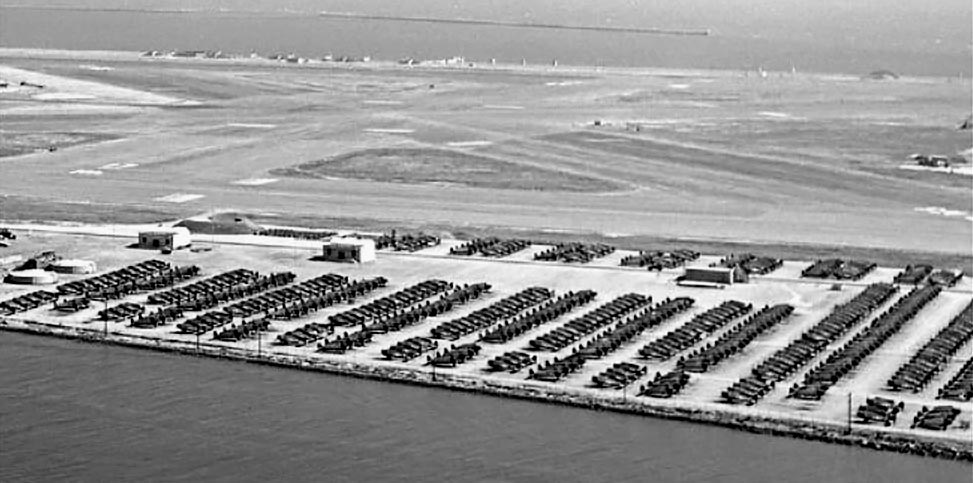
A 5/5/47 aerial view by Bill Larkins of an amazing array of over 400 F6F Hellcat fighters on the west side of NAS Alameda awaiting overhauling or scrapping.

The 1949 USGS topo map (courtesy of Kevin Walsh) depicted Alameda “Naval Reservation” as having 5 runways.
Al Brown recalled, "I was stationed at Alameda in 1953-54. I was a crew member on the JRM Mars seaplane.
We flew to Hawaii & returned twice a week. Travel time was 16 hours flying at 10,000 feet."
A 1955 USN photo of a sporty FJ3 Fury in front of NAS Alameda's Hangar 20 (courtesy of John Voss).
Compare to the photo of the same building, 48 years later, several paragraphs below.

A circa 1955 photo of a row of Martin P5M-2 Marlin flying boats at NAS Alameda.

A 1955 photo of the JRM-1 Marshall Mars on display for civilian visitors at NAS Alameda (courtesy of John Voss).
An undated (circa 1950s) USN photo of a static display at NAS Alameda,
with a F7U-3 Cutlass in the center (courtesy of John Voss).
Lanny Giorgi recalled, “I grew up just outside of the NAS Alameda & had the opportunity to go there often in the 1950s, 1960s & 1970s.
The carriers used to have air operations while docked & we were right under their final approach.
I knew the jets by sound. I loved it but my parents didn't. Especially during night operations.”

A 1956 photo of a Convair R3Y-2 Tradewind "Caribbean Sea" (131723)
of VR-2 leaving the seaplane docks at Alameda (courtesy of Bill Larkins).
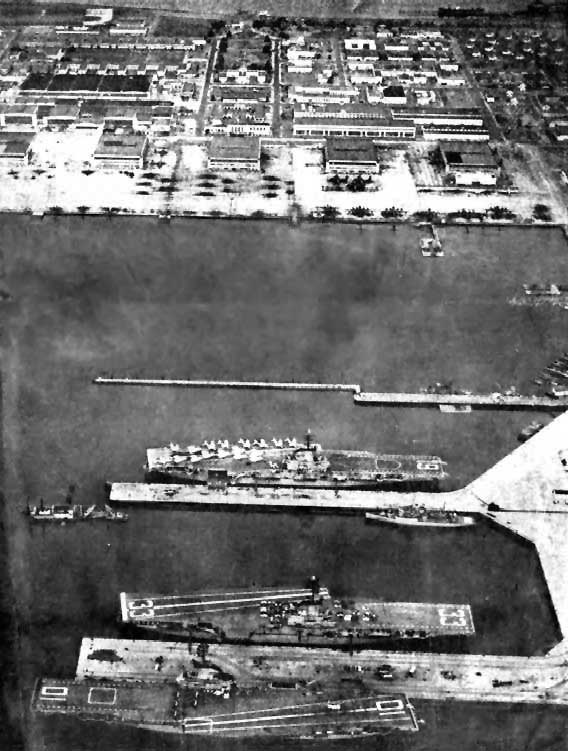
An undated aerial view looking north at the Alameda lagoon & hangars,
with the USS Hancock (CV-19), USS Kearsarge (CV-33), and USS Yorktown (CV-10) in port for the 17th Anniversary of the base opening
(from 11/1/57 issue of The Carrier newspaper).
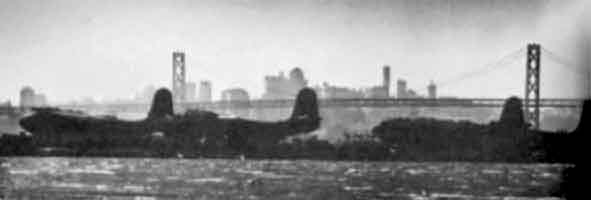
A late 1950s photo by Bill Eaton of the surviving fleet of Martin Mars seaplanes
at NAS Alameda after they were retired & put into storage.

A July 1963 photo by William Larkins of a Curtiss C-46F, N69346 at NAS Alameda.
According to William, “Quicktrans was a contract service at that time for civilian operators to carry freight for the Navy.”

An undated photo of A-4 Skyhawks in the Alameda Naval Air Rework Facility.
In postwar years, one of the most important tenants at Alameda was the Naval Air Rework Facility,
a depot for various naval aircraft.
A wide variety of Navy & Marine Corps aircraft units were stationed at Alameda.
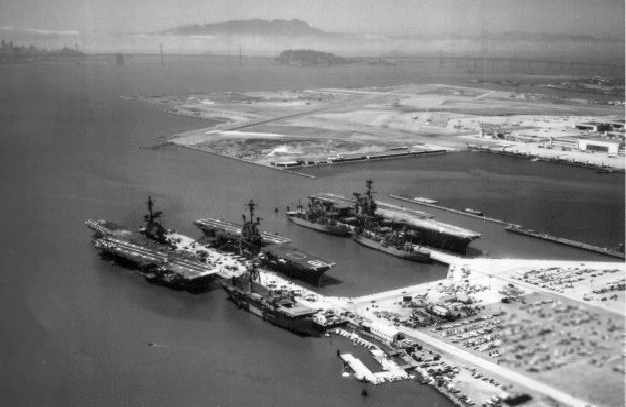
An undated (circa 1960s?) aerial view looking northwest, showing 3 aircraft carriers docked at the piers,
with NAS Alameda behind them, and the an Francisco skyline at the top left.
Alameda served as the homeport for several aircraft carriers,
with piers large enough to accommodate the largest carriers in the fleet.

A May 1967 photo of an all-black RA-3B Skywarrior on a wet Alameda ramp.

A 4/20/68 aerial view of Alameda.

The 5/1/69 San Francisco Sectional Chart depicted NAS Alameda as having 2 paved runways,
with the longest being 8,000'.

An undated (circa 1960s-70s?) aerial view looking west at NAS Alameda, with Treasure Island also visible in the background (courtesy of Kevin Walsh).

An undated photo of NAS Alameda's control tower.
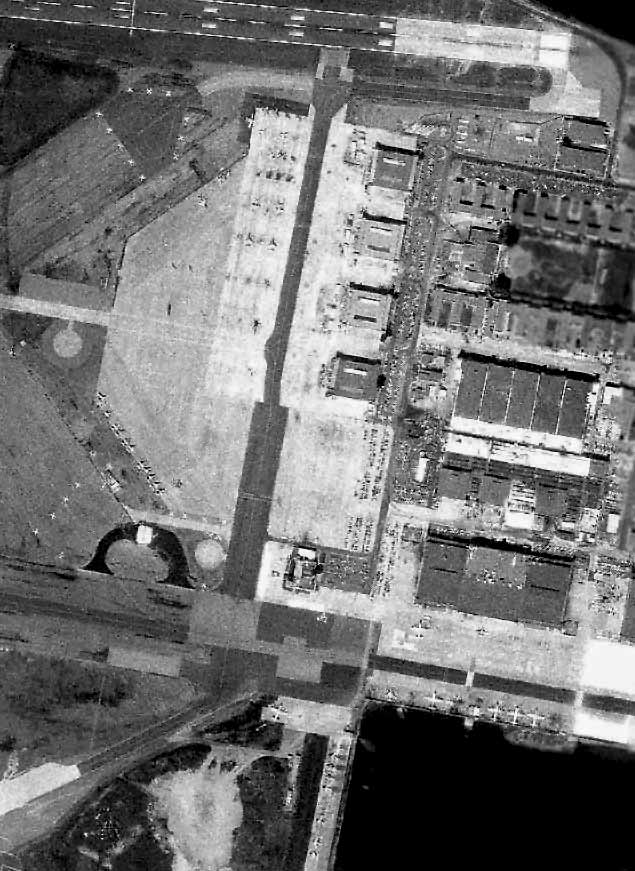
A 1984 aerial view of Alameda, showing a large number of tactical aircraft on the ramp at the bottom,
as well as P-3 Orions along the former seaplane ramp along the east side.

A 1988 airport diagram of Alameda NAS.
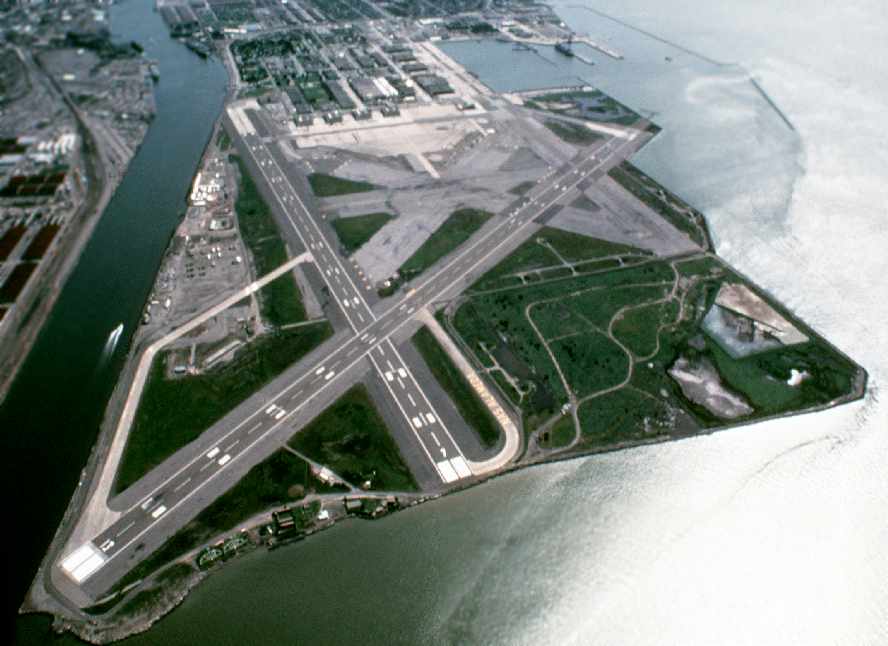
A January 1989 DOD aerial view looking southeast at NAS Alameda.
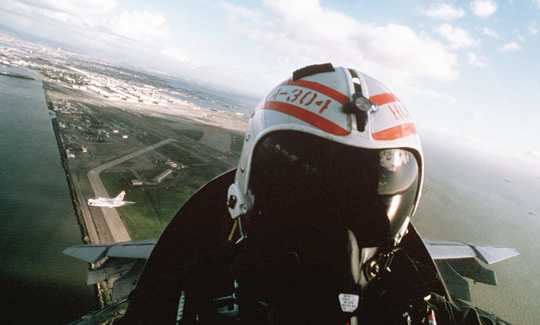
A 10/29/90 view of the pilot of a Naval Air Reserve VA-304 A-7E Corsair II, with his wingman visible on the left,
after having taken off from Alameda, with the base visible below.

A 1993 USGS aerial photo of Alameda, shortly before it closed (note a few aircraft still on the ramp).

The 1996 USGS topo map depicted the massive airfield infrastructure of the Alameda NAS.
Alameda NAS was closed on 4/25/97 as part of the Base Closure & Realignment process.
At the time of its closure, 2 asphalt runways were still maintained (the largest, 5/31, was 8,400').
Civil reuse plans did not include any aviation uses.

A mile & a quarter long section of "freeway" which was constructed on the former Alameda runways
in 2001 as a movie set for the film "The Matrix Reloaded" (courtesy of Eric Barbour).
According to Eric Barbour, the former runways at Alameda were used in 2001 to film part of the movie "The Matrix 2".
An entire 3-mile-long section of freeway was constructed on part of Runways 13 & 25.
Warner Brothers removed the set after filming,
but the layout of the roadway sections were still perceptible on the runways.
A beautiful 2003 photo by Erick McCarthy of the San Francisco skyline behind the remains of the runways at NAS Alameda.
A 2003 photo by Erick McCarthy looking south along the parking apron,
with the hangars & control tower of NAS Alameda visible on the left.
A 2003 photo by Bill Larkins of a Douglas A-4 mounted on a pylon at Alameda.
A 2003 photo by Bill Larkins of a loaded Vought A-7, mounted on a pylon at Alameda.

A 2003 photo by Tim Tyler of Building 77 at Alameda - still marked as the "Air Terminal".
Tim Tyler visited the former NAS Alameda in 2003.
His report: "Hello from 37-46.86 N / 122-17.96 W,
the ramp area in front (south) of the former NAS Alameda Building 77 - the old Air Terminal Building.
Building 77 is on the east end of this ramp area,
with the newer ATC/Terminal Building being on the west end.
The newer ATC building is actually the corner, as the hangars & ramp area basically form an 'L' shape."

A 2003 photo by Tim Tyler of the remains of a seaplane ramp,
with several former Navy ships in the background.
Tim Tyler continued, "I rode my bike all around the ramp area this afternoon,
seeing / photographing the numerous old seaplane ramps
(including one that seemed to have been converted from a barge),
the faded helicopter LZ markings, and four major hangars.
Three in a row & then one located right behind Building 77.
NAS Alameda is now known as Alameda Point, and is pretty much owned by the city of Alameda now.
I'd say maybe 40% of the NAS properties are redeveloped,
but that number could be substantially greater
if some companies have just chosen not to put any signs up on their doors or something."

A 2003 photo by Tim Tyler of "a very large, metal NAS Alameda emblem,
mounted on the wall next to the doors at the old Air Terminal."
Tim Tyler continued, "Building 77 looks like it dates back to the 1930s or 40s, several stories tall,
with 'Air Terminal' lettering on the ramp-side of it.
There are several historical markers around the steps leading to the door,
and a large NAS Alameda emblem is still up on the wall next to the doors.
This building was apparently a NAS Alameda Museum at one point,
however a piece of paper still posted on the glass doors indicated that the museum was still looking for volunteers,
and they were anxious because they had a 2001 opening date.
Peering in through the window, the ground floor area was full of miscellaneous junk,
but not dirty or showing any signs of vandalism.
Apparently the museum group suffered from a variety of mismanagement, and was short-lived.
Some of the aircraft that were on loan to them is now aboard the USS Hornet,
moored several hundred yards away."
A 2003 photo by Tim Tyler.
"The Pan American Airways System artwork is on the side of one of the old hangars behind the old Air Terminal building.
I'm assuming it was a hangar used by Pan Am Clippers back in the day."
Tim Tyler continued, "The hangar behind the Air Terminal is Hangar 41, the 'AIMD' [Aircraft Intermediate Maintenance Department] Hangar.
It's unusual in that it has a small Quonset hut located along the south side of the doors,
and an old cipher lock on the personnel door, located in between the 20'x40' Quonset hut & the hangar."

A 2003 photo by Tim Tyler of NAS Alameda's Hangar 40.
"The next major Hangar, number 40, is now the Bladium Sports Club, at 800 West Tower Avenue."
Tim Tyler continued, "Hangar 39, 950 West Tower Ave, is now Delphi Productions,
which based on what I saw when I peered in one of the windows,
is involved with helping design, build & ship exhibits for trade shows.
The south side of this hangar is at 37-46.9 N / 122-18.19 W.
Based on some painted-over stenciling ('HS-85 Parking Only') on the side,
this hangar had been used by Navy Helicopter Squadron 85."
Tim continued, "The next hangar west is number 12,
which according to some very faded/perhaps painted over lettering was the 'NARF Emergency Repair Hangar 12' once,
but from all external appearances, it seems unused these days.
However, in peeking through a window, I did observe a 2003 calendar on the wall of a work area.
On the ramp about 50' back from this hangar are some 'humps' in the concrete
which seemed to provide some power & liquid receptacles for parked aircraft.
Building 12 is a very large hangar, perhaps 700' long on it's south side.
It has several street addresses - 1090 & 1190 West Tower Avenue.
The '12' numbers are on the hangar doors on the east end of the building.
The doors on the west don't have a hangar number above them,
but the doors on the number side indicate it is Hangar 11."
Tim continued, "Hangar 25 is a newer (at least 1970s) hangar
and is on the opposite side of the ramp from the ATC Tower.
It had three separate bays to it,
and the east end is at 37-46.83 N / 122-18.60 W.
It seems mostly to be used these days for indoor antique shows & flea markets.
It was used to remove the canons from aircraft,
which would then be taken to nearby Building 29.
Behind (south) it seemed to be some sort of power production facility,
and then Building 494 (1851 Monarch Street),
which is an ancient looking corrugated steel warehouse type building
with several storage bays that have newer cars in them."
Tim continued, "A couple hundred yards South of Building 494 is Building 29.
It's in an isolated area, with it's own security fencing,
and seemed to have old CCTV camera mounts in all four corners of the fenceline.
It's a fairly modern poured concrete building, with a variety of ventilation ducts on the roof.
The entrance door was hardened, and next to it is a 10'x15' equipment door.
An American flag is flying on the roof, and per a sign up on the fence,
this building is now used by Rosenblum Cellars.
It turned out this is the former aircraft cannon test firing cell facility,
and was hardened in case of misfires or explosions."
Tim continued, "Heading back due north, past Hangar 494 a couple hundred yards,
is the ATC Tower at 2175 Monarch Street.
This is a fairly modern structure in very good condition, and is attached to some other buildings,
which to me indicates it became the new Air Terminal facility.
It's now used by the Alameda Point Community Partners -
the name of the entity in charge of redeveloping the former NAS.
The SE corner of this site has three Mark-22 naval artillery pieces on their original mounts,
built in Detroit, Michigan in the 1940s."
Tim continued, "Right at 37-46.94 N / 122-18.63 W was some sort of large emblem
painted onto the gray concrete ramp area in front the runway-side entrance to this building.
For some reason, it has been painted over in black paint,
but it read 'Naval Air Station Alameda California'
and had a red, white & blue shield in the center."
Tim continued, "Continuing north on the ramp area past the ATC/Terminal Building puts you on the other part of the 'L' shape.
The runway area is west, but it's fenced off with numerous 'No Tresspassing' signs,
indicating that the area is now a California Least Tern nesting area.
This was the site in particular I was hoping to be able to access with my bike.
Off in the distance, near the bay I can see 2 munitions igloos near the southwest corner of the runway area.
More towards the center is a series of several small concrete buildings & one Quonset hut structure.
A couple of cars and a motorhome are parked in their vicinity.
One of these buildings is marked as Building 499, and based on the ventilation ducts on the side,
perhaps it was a generator or transformer building for the airfield lighting system?
It turns out that the Terns don't care too much for the peace & quiet,
so there is some discussion amongst the powers-that-be
to re-use some of this valuable bay-front land with spectacular views of the San Francisco skyline.
As it is, the City of Alameda rents out access to the former runways frequently -
Hummer built a temporary course to demonstrate their vehicle's prowess,
General Motors has leased the grounds to provide demo rides of their products, etc."
Tim continued, "Hangar 24 is north-northeast of the Terminal Building a couple hundred feet,
and is a modern hangar with a lot of heavy-duty ventilation on the roof.
It's now used by Coach Specialties Inc. and is the former aircraft painting facility.
Coach Specialties uses it to paint large buses."
Tim continued, "The North end of it seems to be used by another firm.
There were about a dozen strange looking 4 door cars known as 'Cayenne Turbos'
but no manufacturer name or logo.
Turns out they're a new Porsche product,
brought in to test driven by Bay Area Porsche enthusiasts his weekend."
"The next hangar north is number 23, now apparently used by 'WCN' company.
Next is Hangar 22 at 2501 Monarch Street, now used by Creative Technology.
Hangar 21 is/was used as a factory by Kitz Direct Seal Valves, but sure looks like it is unused now.
On the runway side of Hangar 21, 'Welcome from the Firebirds' is still easily legible along the roofline.
These hangars were formerly home to Marine Corps aviation squadrons."

A 2003 photo by Tim Tyler of NAS Alameda's Hangar 20.
Compare to the photo of the same building, 48 years before, several paragraphs above.
Tim Tyler continued, "What should be Hangar 20 does have any Hangar or Building number markings up,
but it is occupied by Ocean Systems Inc, Protector Boats, Juniper Ridge, and Edge Innovations.
Protector Boats is a series of harbor patrol type RIB/RHI boats, and several were stored outside.
On the west (runway) side of this building, at 37-47.3 N / 122-18.60 W should be exactly where
the F-3J 'Fury' aircraft was parked when the photo [several paragraphs above] was taken.
It's kind of eerie to be parked in that exact spot right now, while I look at that photo from 1955.
The tower cab is no longer up on the end of the hangar.
Further north of Hangar 20 is a large, paved area that's vacant,
and then an active Port of Oakland commercial shipping area beyond that."
Tim continued, "On the west-northwest side of the runway area is the former modern WSA for 'special' weapons.
That portion of the base also had a small arms firing range, and south of this area, I spotted the field's tetrahedron."
Tim continued, "The former NAS Alameda is a very large installation,
with lots of areas to explore, however in this visit & report,
I'm tending to focus on the aviation-related aspects.
There were numerous other large hangars
(I've been informed that Hangar 5 has about 1,000,000 square feet of floor space)
that I'm not even mentioning,
because they're set back behind others & not up against the flight line."
Tim continued, "I was extremely lucky to stop & talk with an Alameda PD officer,
who happened to be a retired Marine who was stationed aboard the USS Carl Vinson
during the time the Vinson's home-port was NAS Alameda.
He confirmed numerous educated guesses I'd made,
allowing me to revise some tentative wording in this Situation Report to something definitive."
Hugh Black reported in 2003 that he works for Protector Boats & Performance Boats,
which is located in Alameda's former Hangar #20.
"This is an old helo hangar.
There are still diagrams on the wall of the different types of helos... size, dimensions etc. (very cool)."

As seen in the February 2004 USGS aerial photo,
the former airfield remained almost completely intact,
with an extensive network of runways, taxiways, large ramp areas & numerous hangars.
However, note the movie-set 'freeway' which had been constructed over several of the runways.
Scott reported in 2004 "that a couple of WWII veterans have just opened a museum [the Alameda Naval Air Museum]
in the old Air Terminal Building in Alameda Building 77 of the old Naval Air Station.
It is open on the weekends & features the local history.
As you come through the gate on Atlantic Ave when you reach the fork it is on your right."

A 2004 photo by Tim Tyler looking east at Alameda's abandoned hangars.

A 2004 photo by Tim Tyler looking west along one of Alameda's abandoned runways, with the San Francisco skyline in the background.

A 2004 photo by Tim Tyler of one of Alameda's abandoned former munitions storage bunkers.
Tim Tyler visited the abandoned NAS Alameda again in 2004.
"The entire airfield area is fenced, but on occasion, the gate for the northern half is open,
and I was able to drive around this portion.
Besides part of the runway & taxiway areas,
the only thing that's really there is the former weapons storage areas -
an older conventional munitions area,
and then an adjacent compound that had been guarded by a contingent of Marines, and stored nuclear weapons."
Tim continued, "There was another fence running East/West & cutting the airfield in half.
This other half of the airfield is this silly wildlife preserve & very much off-limits to unauthorized people,
though there was some sort of truck driving around there.
This half of the airfield has a couple large munitions igloos towards the SW corner,
the old shooting range, windvane, and a couple other miscellaneous buildings."

A beautiful August 2004 photo © by AirNikon (used by permission),
looking west with the site of the former San Francisco Bay Airdrome in the immediate foreground,
the closed NAS Alameda in the middle,
and the skyline of San Francisco in the background.
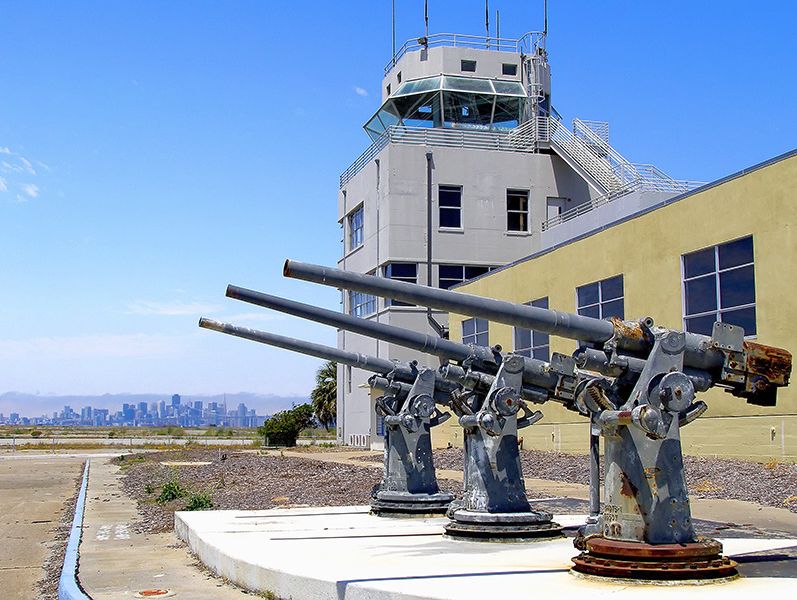
A 6/23/06 photo of 3 Mk.22 naval guns mounted in front of Alameda's former control tower.
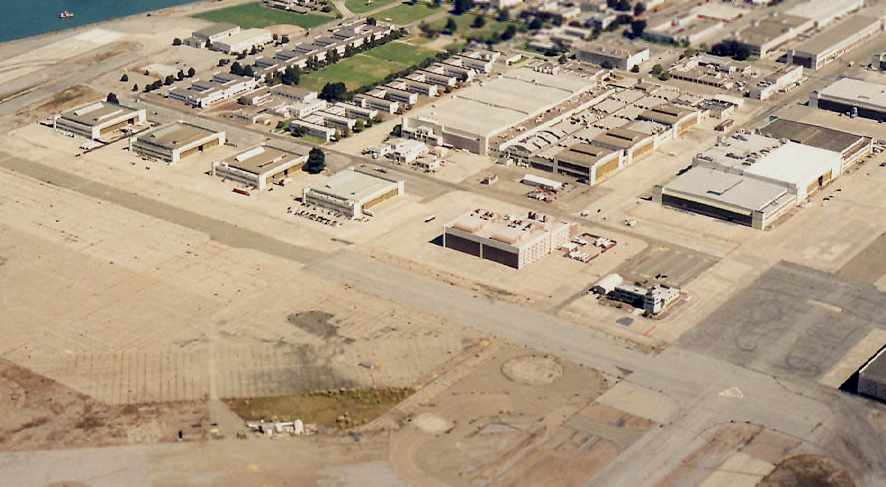
A 2006 aerial view by Bill Larkins looking northeast at the Alameda ramp, hangars, and control tower.
Adrienne Simpson reported in 2006, “I work for Hangar One vodka,
which occupies Hangar 21 on the former Alameda Naval Air Station.”

A December 2006 aerial view by Ian Carisi looking southeast along Alameda's Runway 13.

A November 2007 aerial view by Ian Carisi looking south at Alameda's former control tower.

A circa 2008 photo of the hangars of Alameda's Naval Air Rework Facility.

A circa 2010 aerial view looking north at the “wreckage” of a 737 on Alameda's Runway 7,
presumably set up as part of a movie set.

An undated aerial view of 4 A-4 Skyhawks over NAS Alameda,
on the cover of Bill Larkin's 2010 book “Alameda Naval Air Station”.
In June 2011 Alameda's A-4 was seriously damaged when it toppled over when a crane was attempting to re-mount the A-4 on its display pylon.
Tim reported in December 2011, “After only 2 months & 26 days all the damage that occurred in June 2011 was repaired &/or fixed.
It is now remounted & it looks like nothing ever happened. From tragedy to triumph.”

A 1/1/12 photo by William Larkinns of “the beautiful A4D-1 is now mounted at the main entrance to the old NAS Alameda - now called Alameda Point.
It is in its correct historical markings when it was in VA-113.”

A 4/13/15 aerial view by Dallam Oliver-Lee looking southwest at NAS Alameda.
What a shame to see such a massive amount of aviation infrastructure going to waste.

A 4/13/15 photo by Dallam Oliver-Lee of a former NAS Alameda hangar.
Dallam reported, “A lot of the buildings have been rented out by companies. Only a few buildings were abandoned.”
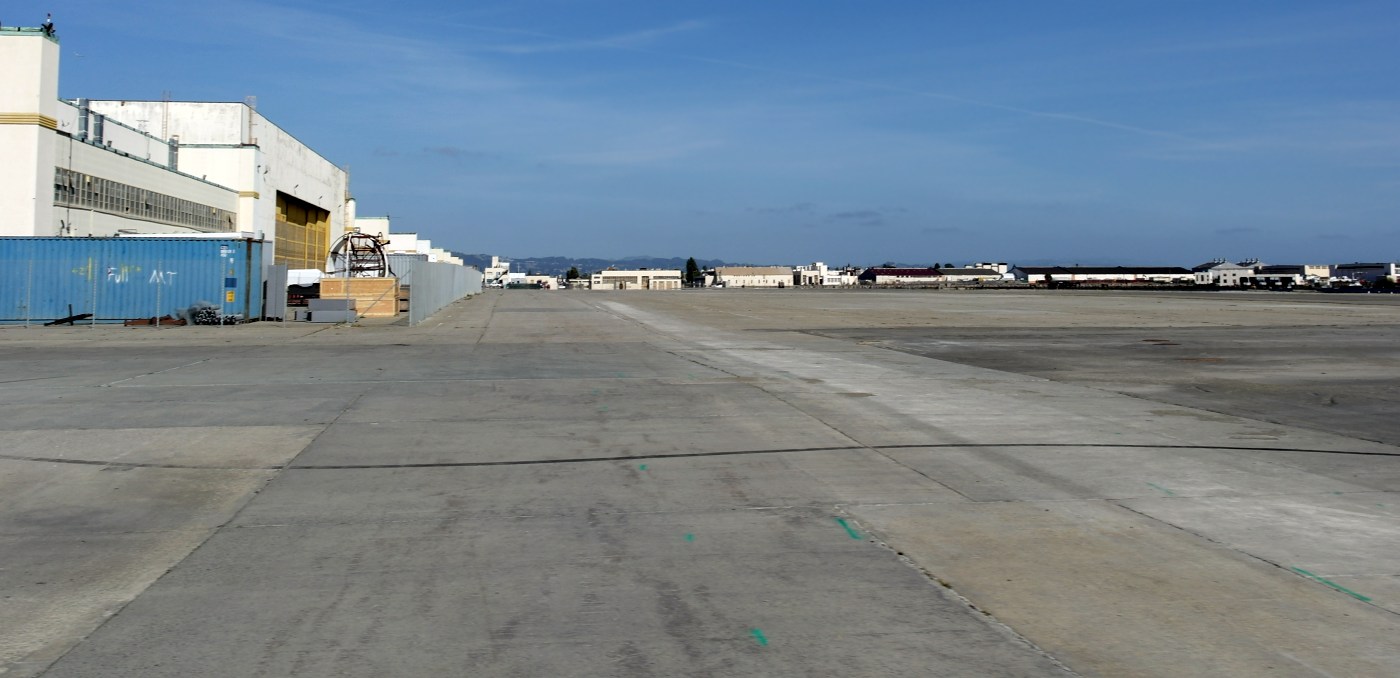
A 4/13/15 photo by Dallam Oliver-Lee of the massive NAS Alameda ramp.

A 5/11/16 photo by Kevin Walsh of the heavily-loaded Vought A-7 mounted on a pylon at Alameda.

A 10/27/16 photo (courtesy of Kevin Walsh) of the last plane to land (for now) on the NAS Alameda runway - a Cessna 172 which made an emergency landing.
At least all of this extensive infrastructure is still being put to some aviation use.
See also: www.vpnavy.com/nasalameda.html
____________________________________________________
Since this site was first put on the web in 1999, its popularity has grown tremendously.
That has caused it to often exceed bandwidth limitations
set by the company which I pay to host it on the web.
If the total quantity of material on this site is to continue to grow,
it will require ever-increasing funding to pay its expenses.
Therefore, I request financial contributions from site visitors,
to help defray the increasing costs of the site
and ensure that it continues to be available & to grow.
What would you pay for a good aviation magazine, or a good aviation book?
Please consider a donation of an equivalent amount, at the least.
This site is not supported by commercial advertising –
it is purely supported by donations.
If you enjoy the site, and would like to make a financial contribution,
you
may use a credit card via
![]() ,
using one of 2 methods:
,
using one of 2 methods:
To make a one-time donation of an amount of your choice:
Or you can sign up for a $10 monthly subscription to help support the site on an ongoing basis:
Or if you prefer to contact me directly concerning a contribution (for a mailing address to send a check),
please contact me at: paulandterryfreeman@gmail.com
If you enjoy this web site, please support it with a financial contribution.
This site covers airfields in all 50 states.